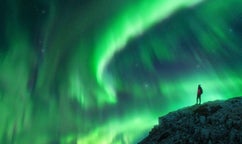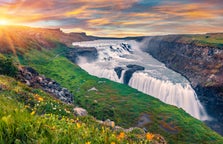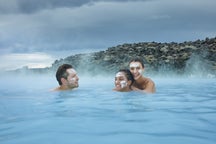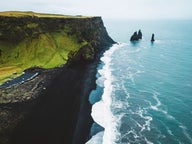In this travel-blog I want to show you the most popular place to visit in Iceland - the Geysir geothermal area, where you can see boiling mud pots, fumaroles and Strokkur, which erupts every 7-8 minutes and spouts boiling water some 25-35 m into the air.
The Geysir geothermal area is on the Golden Circle route, the most popular of the Jewel circles in Iceland. The Golden Circle includes some amazing sights, the best-known are the Gullfoss waterfall, the Geysir geothermal area, Þingvellir national park and Kerið crater.
There has been increased activity at the Geysir geothermal area so you will see more spouting and boiling and bubbling hot pools.
Top photo: Strokkur erupting
 Strokkur erupting
Strokkur erupting
The Geysir geothermal area is a big attraction on the Golden Circle.
I show all my foreign visitors these beautiful sights and I never tire of visiting them. I also include a visit to the Skálholt episcopal See, which is one of Iceland's most historical places, as it served as the center of ecclesiastic power in Iceland for 740 years.
I believe that most foreign visitors to my country visit the Golden Circle.
Apart from those who have only a few hours to spare while stopping over at the airport; they visit the Blue Lagoon.
 Strokkur erupting - it is at its most beautiful when the sky is blue and it doesn't blend in with the clouds
Strokkur erupting - it is at its most beautiful when the sky is blue and it doesn't blend in with the clouds
I once took 60 foreign friends from a group that I belong to, to Geysir and it was one of the worst days of the summer with warnings of swellings of rivers in the south! Bad luck, eh, as my friends missed the beautiful sight of seeing Strokkur erupting.
For obvious reasons (explained in the next chapter of this travel-blog) I have no photos of Geysir erupting, but I long to see it erupt. So all my photos of erupting geysers in my travel-blog are of Strokkur.
Geysir hot spring
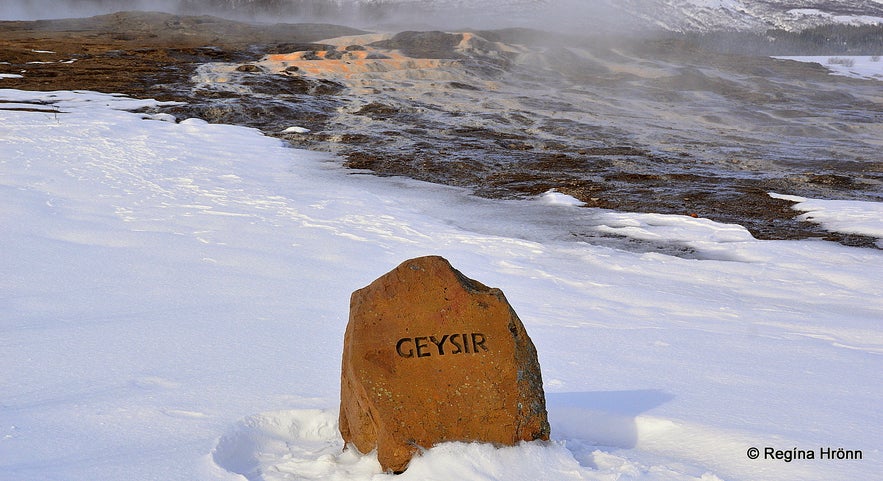 The original Geysir
The original Geysir
The Geysir geothermal area is a well-known high-temperature geothermal area. And Geysir itself is one of the best-known geysers in the world and has given a name to other spouting hot springs around the world; geyser.
In Icelandic, the term Geysir is derived from the verb gjósa, which means to erupt.
The Icelandic pronunciation of Geysir is like "hey!" while the English pronunciation is more like "hi" or "he". You can hear the Icelandic pronunciation here.
Another word derived from the original Geysir is geyserite, as characteristic of the old Geysir is the huge geyserite which surrounds it.
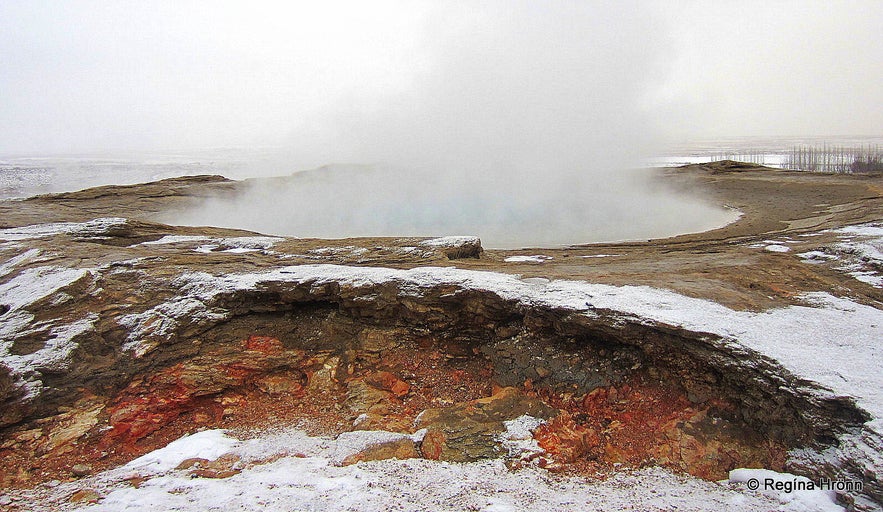 Geysir in the wintertime
Geysir in the wintertime
Geysir is almost dormant these days, but what you can see now when you visit the original Geysir is the 18 m in diameter bowl surrounded by thick geyserite (hverahrúður in Icelandic). The geyserites are among the most beautiful features of the geothermal areas in my opinion.
The shaft of the hot spring is around 20 m deep. It is difficult to get a decent photo of Geysir and the bowl as it is fenced off. And the Geysir geothermal area is a no-drone zone.
Geysir is believed to have started erupting after a big earthquake, Suðurlandsskjálftinn, in 1294. That is the first time this area was mentioned in written sources, Oddaverja annáll. But it might be much older or younger than that as the sources only mention that some hot springs disappeared and new ones appeared.
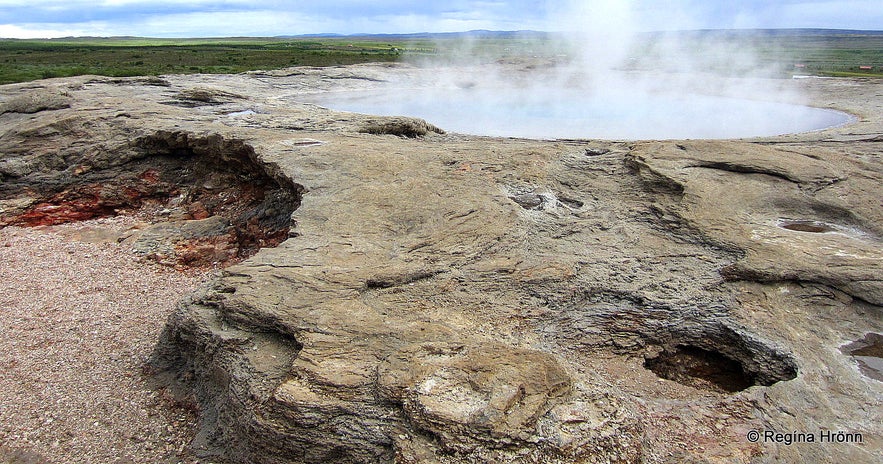 A huge amount of geyserite surrounds the Geysir bowl
A huge amount of geyserite surrounds the Geysir bowl
Geysir was at its most active following these big earthquakes in the south, and it was apparently very active following the earthquake in 1630. Following these earthquakes, new hot springs emerged and others disappeared in the Geysir geothermal area.
There were other big earthquakes in 1789 and 1896 (we think that there were 5 big ones that year) which changed the geothermal area and the frequency of Geysir's eruptions.
These big earthquakes are called Suðurlandsskjálftinn - the South-Iceland Quake, and they happen at an approximately 100-year-interval, the last one shaking South Iceland back in 2008 (6.3 on the Richter scale).
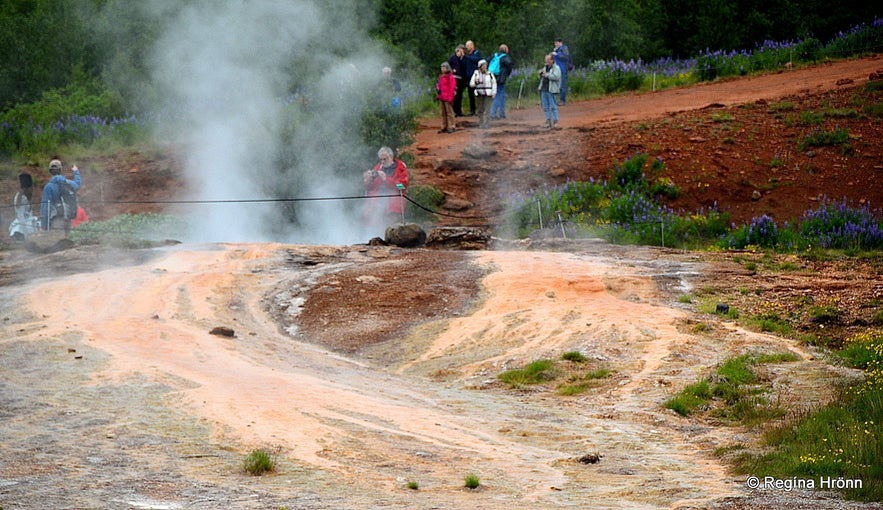 Geysir is very colourful as seen from the east side with beautiful peach and white geothermal colours
Geysir is very colourful as seen from the east side with beautiful peach and white geothermal colours
On the 17th of June 2000 (our National day), we had a big earthquake, and another one on the 21st of June, 6.5 on the Richter scale; and Geysir started erupting again on average 3 times a day for some period of time.
These earthquakes sometimes come in pairs and a pair of earthquakes shook South Iceland as well back in 1912.
We, who live in this part of Iceland, dread these Suðurlandsskjálfti earthquakes. When I was a kid we often passed by Mt. Ingólfsfjall and my grandparents and parents always used to mention that the big earthquake was due, scaring the living daylights out of me.
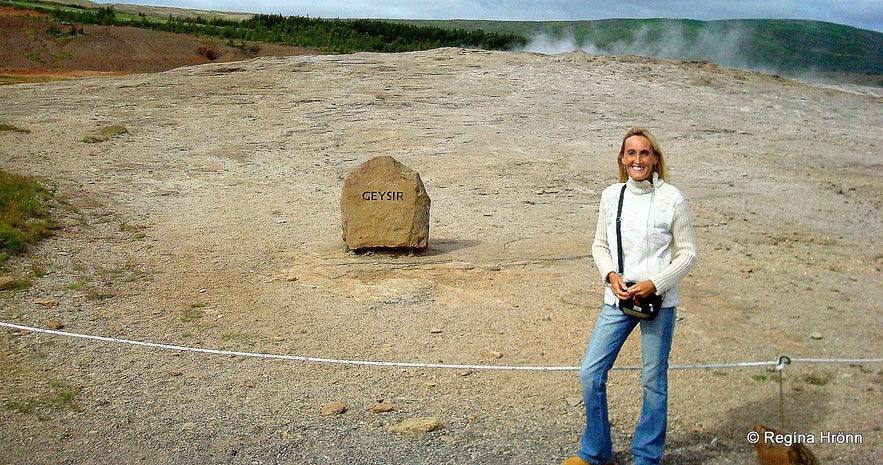 By Geysir
By Geysir
But it so happened that the epicentre of the 2008 earthquake was right beneath Mt. Ingólfsfjall.
When you pass this mountain in the south you will see big boulders which have rolled down the mountain hills during such earthquakes.
See also:
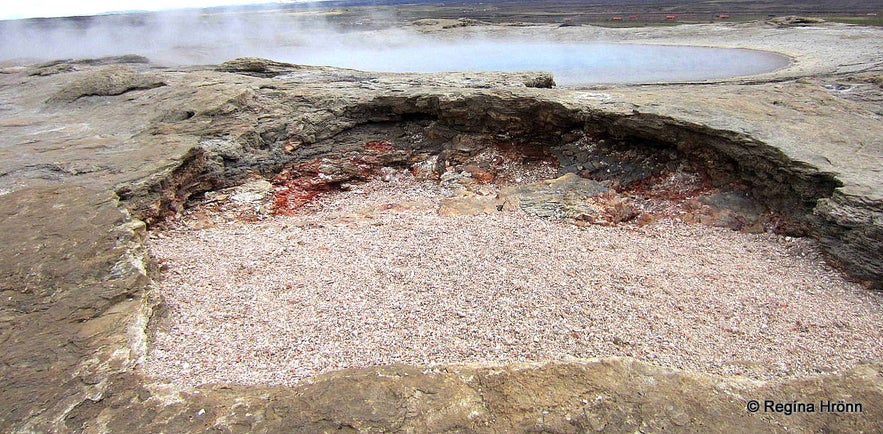 The brittle geyserite has broken here
The brittle geyserite has broken here
Geysir slowly stopped erupting after the turn of the 20th century and became dormant after 1916. In 1935 a furrow was made in the bowl to lower the water level which made it erupt again until 1950. The split then got filled by sinter with time.
Then in August 1981 a well-known Icelandic filmmaker, Hrafn Gunnlaugsson, my husband's second cousin, opened the furrow, as he wanted Geysir to erupt for one of his films "Okkar á milli í hita og þunga dagsins".
Remember, that technology wasn't as advanced back then, so a real eruption was needed for the filming.

Hrafn talked to the farmers at Geysir, reopened the furrow and enlargened it. This was not well regarded as the furrow was thought to be unsightly, but Geysir started erupting again.
Geysir and the geothermal area was not protected but are on the Nature Conservation Register. On the 17th of June 2020 - our national holiday, the Geysir geothermal area was finally protected.
On big occasions, such as for royal visitors and Verslunarmannahelgin long weekend, the furrow was opened or 40 kilos of soap were put into the bowl forcing an eruption. But that stopped in 1992.
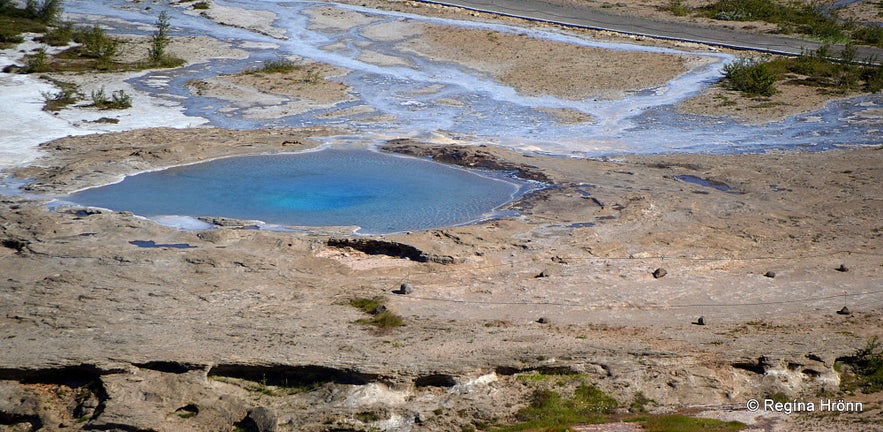 Geysir hot spring
Geysir hot spring
Geysir was a big attraction in Iceland and foreigners would travel to Iceland to see this strange phenomenon. I have read several Icelandic travel journeys from the 18th and 19th centuries written by foreign travellers to Iceland.
And they especially came to Iceland to see Geysir erupt. They didn't seem that interested in the majestic Gullfoss waterfall while staying in this area, just Geysir and Þingvellir.
Back then Europeans didn't know much about other spouting geysers in the world. And together with the Yellowstone Park geyser, Geysir is the most famous geyser in the world.

We have of course no photos from this time, but drawings were made of this spectacular phenomenon. Some of the travellers waited for days to see Geysir erupt, and camped in the geothermal area.
Amongst them was Napoleon (nephew of Napoleon Bonaparte) and his entourage who visited this area back in 1856.
Back then there were no roads and few bridges and these foreign guests would have to hire a guide and travel on horseback, so it would take them a couple of days to reach this area.
Þingvellir, the old parliament of the Vikings, was also a big attraction on the way to Geysir and many would stay for the night at the vicarage there.
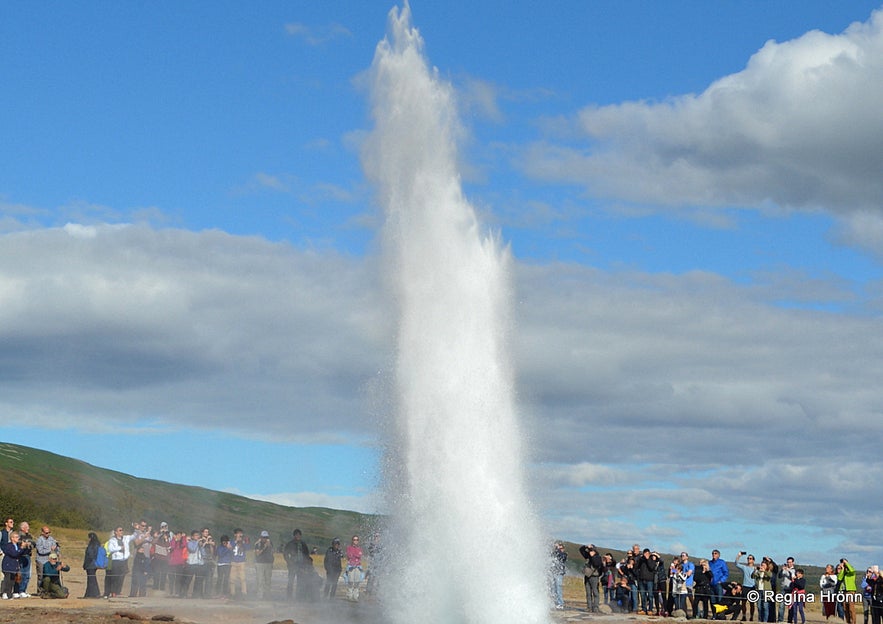 Strokkur erupting
Strokkur erupting
When Geysir erupted back then it must have been a sight to see as it erupted around 60 metres into the air, sometimes even more and sometimes less! And Strokkur also had some majestic eruptions.
Loud thumps are heard before Geysir erupts. In December 2008 after the last big earthquake, a British couple was in grave danger and had to run away from Geysir as it was erupting.
By chance, an Icelandic tour guide was passing by and recognized that the thumps were an indication of a Geysir eruption and could warn them in the nick of time.
I took this photo below back in June 2008, a month after the big earthquake. Then it had not yet been completely fenced off and unsuspecting tourists were standing right next to the bowl, looking into it!
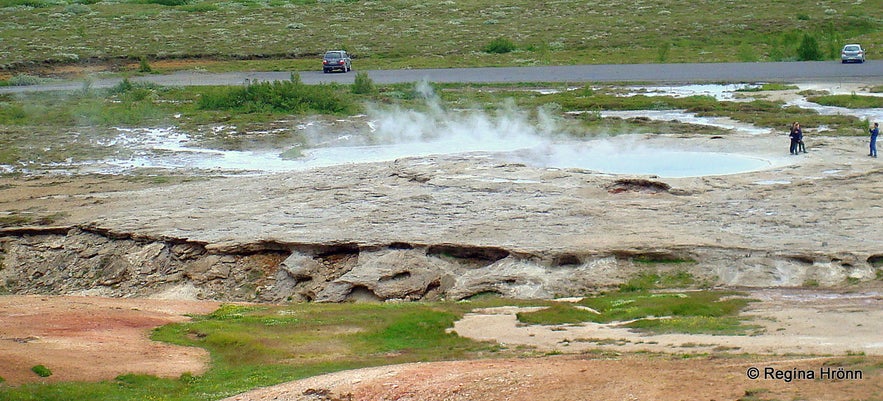 Geysir back in 2008 before it was completely fenced off
Geysir back in 2008 before it was completely fenced off
After that last Suðurlandskjálftinn earthquake, there was no knowing when Geysir would erupt.
I was standing further up in the Geysir geothermal area by Konungshver hot spring, praying that it would not erupt when the tourists were standing on top of it.
You can also see in the photo that the brittle geyserite had not yet broken as much as in my other photos of Geysir.
A Geysir eruption was caught on video back in 2016:
Rare eruption of Iceland's most famous hot spring Geysir
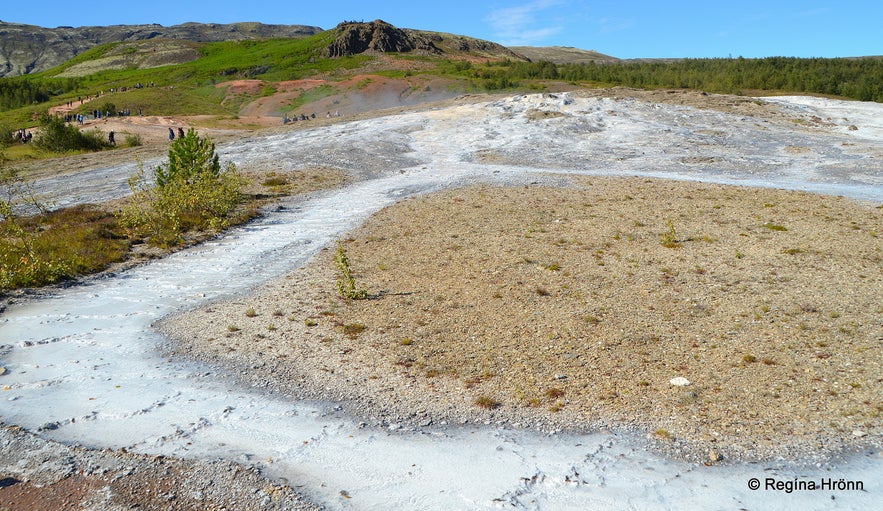 Geysir in 2022
Geysir in 2022
Geysir now only erupts from time to time and has been fenced off, but you can walk very close to it.
I have visited the Geysir area many many times and have never seen Geysir erupt. I would absolutely love to see it though.
Strokkur - the Churn
 A big eruption in Strokkur
A big eruption in Strokkur
Strokkur is the main attraction at the Geysir geothermal area, since Geysir all but stopped erupting.
This spouting hot spring got formed in a big earthquake back in 1789 and was active until 1896.
It erupts now with approximately an 8-minute interval some 25-35 m into the air. But that can change and I have seen it surprise me and erupt when I was totally unprepared, and then erupt again.
 Strokkur in March
Strokkur in March
And it can be a really small eruption or a magnificent one. If it is a small one then I have heard murmurs of disappointment from other travellers ;)
But this is nature and not a show so nothing is certain here.
The name Strokkur means Churn, like in the old instrument for churning butter, and stems from the shape of its shaft.
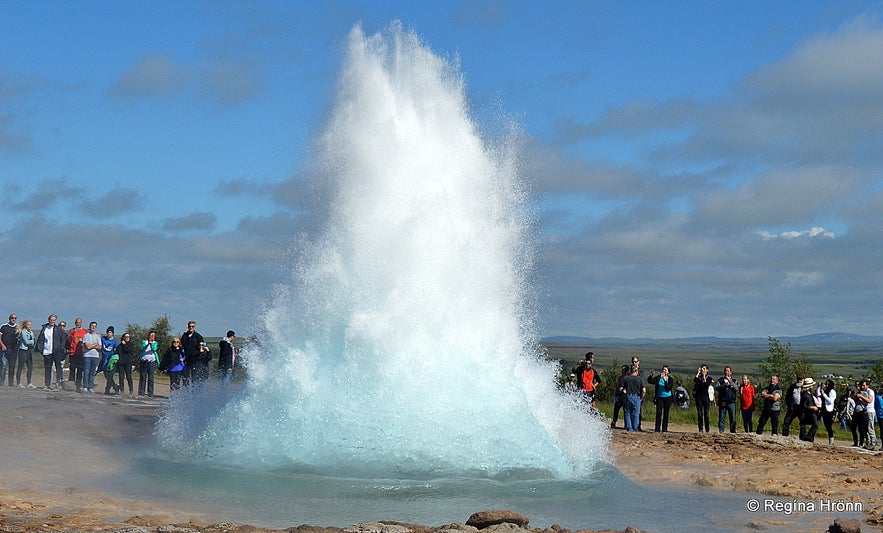 A smaller eruption in Strokkur
A smaller eruption in Strokkur
I also read in an old travel journal, "Íslandsferð J. Ross Browne 1862" that it was called the Churn as it returned everything that was put into it (turf and stones) after churning it.
But it was a common practice "back then" to throw turf into the hot springs to make them erupt. In this book, they put more turf into Strokkur than was the normal amount and Strokkur went amok to try to get rid of it.
When turf was thrown into Strokkur the water spouting in the air turned black!
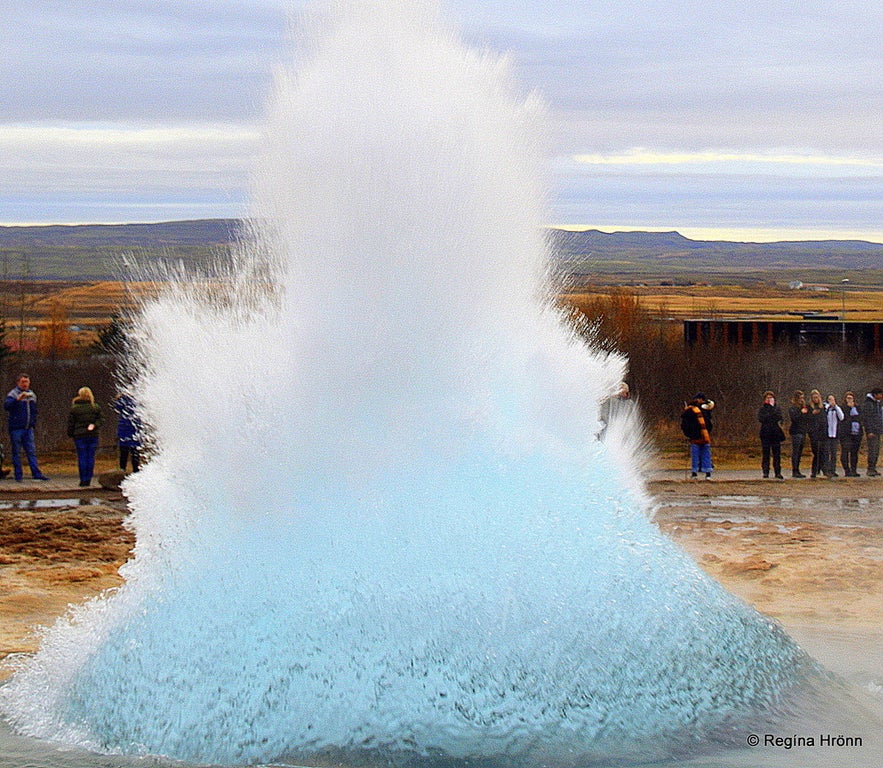 The Strokkur bubble - it is really difficult to photograph in focus
The Strokkur bubble - it is really difficult to photograph in focus
When Strokkur became almost dormant for decades after an active period, measures were taken to clear out the shaft and revive it again, and 40 m were drilled into the shaft.
This was back in 1963 and it has been erupting regularly since.
The way things work here is that this is an active geothermal area with an underground plumbing system, so to speak. Pressure builds up when water comes into contact with a hot basement or bedrock, it heats up and the result is a beautiful eruption.
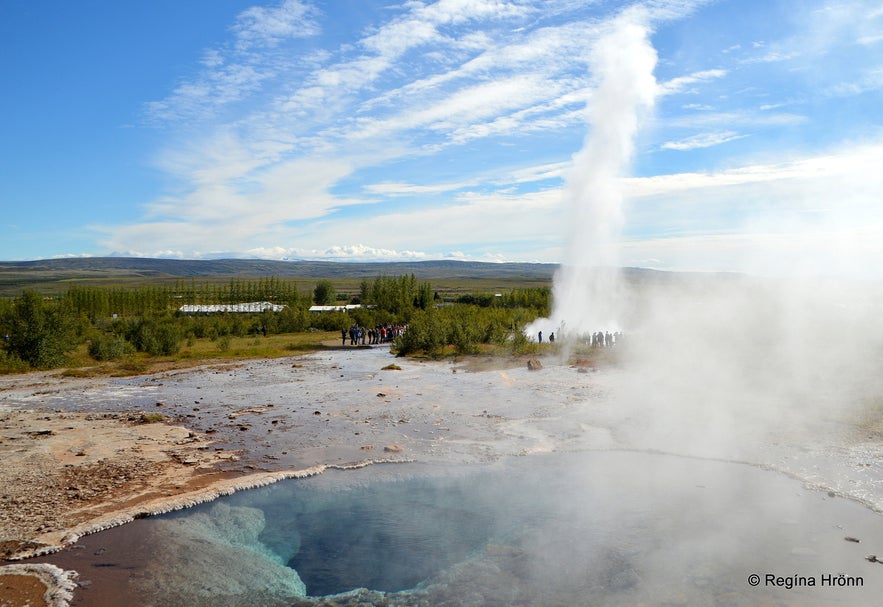 Blesi and Strokkur erupting
Blesi and Strokkur erupting
The hot springs don't have the strong overwhelming smell of sulphur like the mud pots in so many of the other geothermal areas I have visited on my travels in Iceland.
See also:
Mývatn in North-Iceland - Part IV - Mt. Námafjall, Krafla & Leirhnjúkur Geothermal Areas
 The blue bubble appears, about to burst
The blue bubble appears, about to burst
When you visit the Geysir geothermal area you will see crowds around Strokkur awaiting its next eruption.
I always join the crowd, but it can be tedious standing with your camera ready to catch the eruption on film, as Strokkur erupts on average every 8 minutes.
Keep your eyes on the bowl because it shows some signs prior to an eruption. I have stood here in all kinds of weather, once in -10 degrees C and wind freezing my butt off ;)
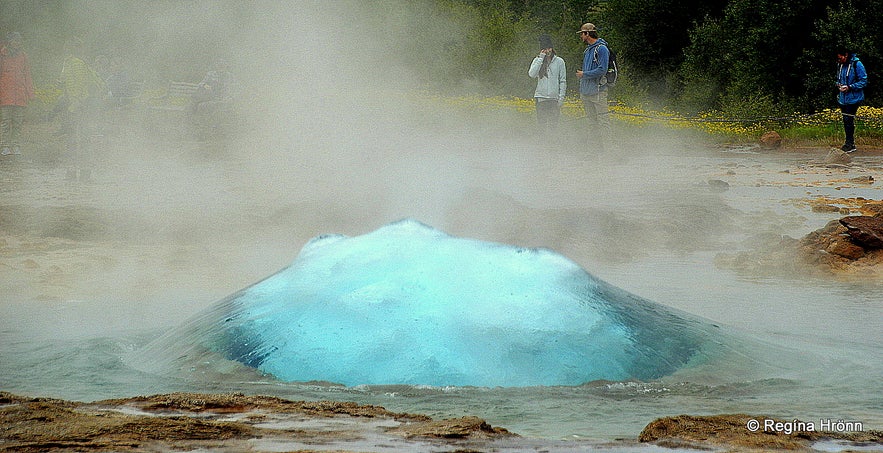 Out of focus, but still cool
Out of focus, but still cool
What I like to do the most is to stand north of it and try to catch a photo of the bubble.
That is pretty difficult and if you press the button too soon or too late then you have to wait for the next eruption.
And I have got so many photos from failed attempts. I must remember to put it on multiple images next time around.

This is my favourite shot of the bubble bursting
Once I was walking upwind of Strokkur when it erupted and I got engulfed in the steam with drops of water landing on my head.
Take that into account when you take your place in the crowds by Strokkur and check from which direction the wind is blowing. I was fortunately too far away for the water to burn me.
See my chapter on "Dangers in geothermal areas" for further information on people who weren't as lucky.
There have been attempts to charge an entrance fee to the Geysir geothermal area, and only a few years ago (2014) I remember it being closed to the public and you could only enter it if you paid an entrance fee.
I was travelling with a group of Canadians, and none of them was willing to pay to enter the geothermal area.
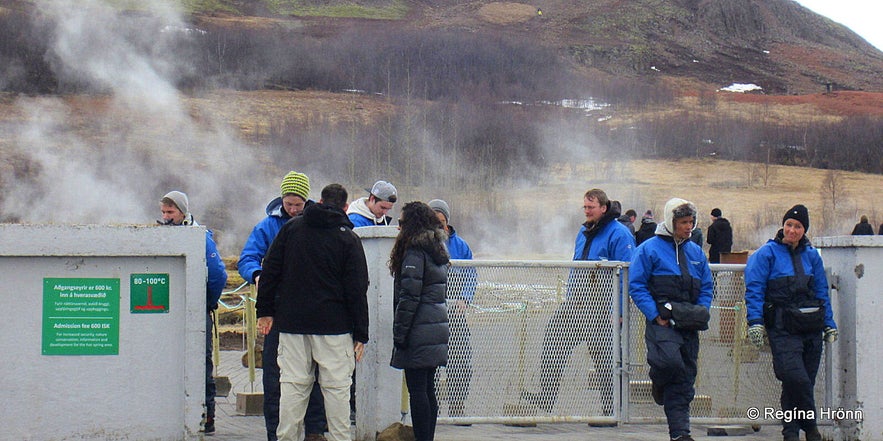
Back in April 2014, when there was an entrance fee to the Geysir geothermal area
But that wasn't the only attempt to charge for admission, as back in 1894 the farmer in Haukadalur sold Geysir to an Englishman. The Englishman, James Craig, charged an entrance fee to travellers.
The lovable Nonni - Jón Sveinsson, visited Geysir back in 1894 and at that time Geysir was pretty active, although Nonni only saw it erupting from afar after he had left this area.
In his travel journal, "A Journey Across Iceland" he mentions that the Englishman, who had bought Geysir, had plans of building a small railway from Reykjavík to Geysir. This never came to fruition though.
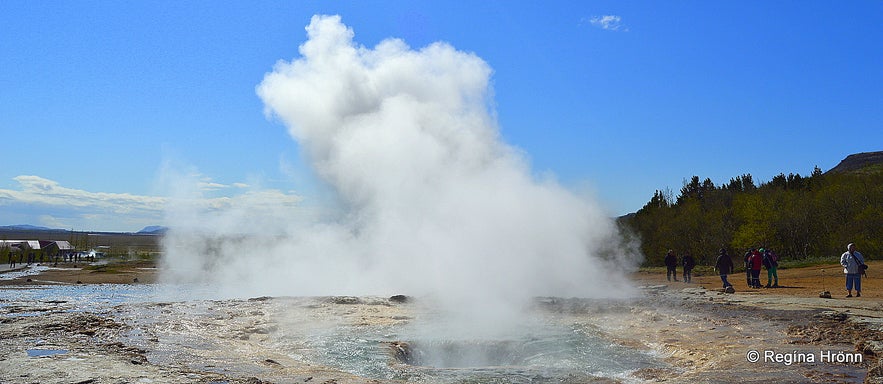 Massive steam follows a Strokkur eruption
Massive steam follows a Strokkur eruption
Geysir changed foreign hands a couple of times until in 1935 a director in Reykjavík, Sigurður Jónasson, bought the land and donated it to the Icelandic nation (around 15.3 ha).
The Icelandic State-owned some 34% of the fenced-off area including Geysir, Strokkur and Blesi, but the rest belonged to other landowners. The Icelandic state sued the landowners and the entrance fee was dropped.
Blesi hot spring
 Blesi looks like two blue eyes or a pair of sunglasses in this photo :)
Blesi looks like two blue eyes or a pair of sunglasses in this photo :)
Blesi hot spring is one of the main hot springs in the Geysir area, above Geysir and Strokkur to the west.
It is divided into two and looks like two blue eyes or a pair of glasses.
I love the absolutely fabulous serene blue colour of this hot spring. You can see the same blue colour at The Blue Lagoon.
Increased activity in Blesi
After the big earthquakes in 2000, Blesi started bubbling and boiling, then it became dormant, only to increase in activity again in 2024.
The whole Geysir geothermal area awakened and we now see much more increased activity in various hot springs and mud pools. We don't know really what is causing this.
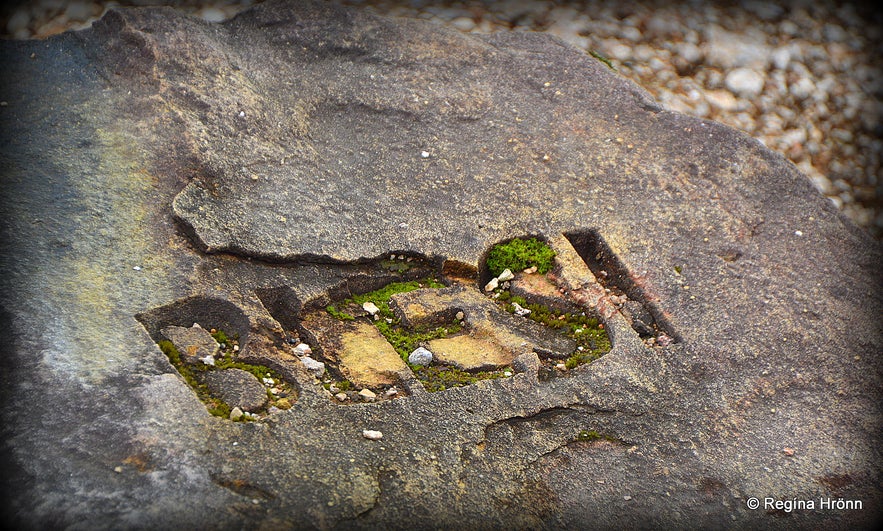 I have seen this blue colour as well at Leirhnjúkur at Mývatn up north. And in Hveravellir in the highland of Iceland I have seen one of the most beautiful hot springs in Iceland; Fagrihver or Fair Hot Spring, with the same blue colour and beautiful geyserite.
I have seen this blue colour as well at Leirhnjúkur at Mývatn up north. And in Hveravellir in the highland of Iceland I have seen one of the most beautiful hot springs in Iceland; Fagrihver or Fair Hot Spring, with the same blue colour and beautiful geyserite.
And Bláhver in the same geothermal area of Hveravellir.
Hveravellir - the beautiful Oasis in the Highland of Iceland
Mývatn in North-Iceland - Part IV - Mt. Námafjall, Krafla & Leirhnjúkur Geothermal Areas
Such hot springs are my favourite hot springs in the geothermal areas of Iceland :) See also my travel-blog: A Local's Favourite Geothermal Areas in Iceland.
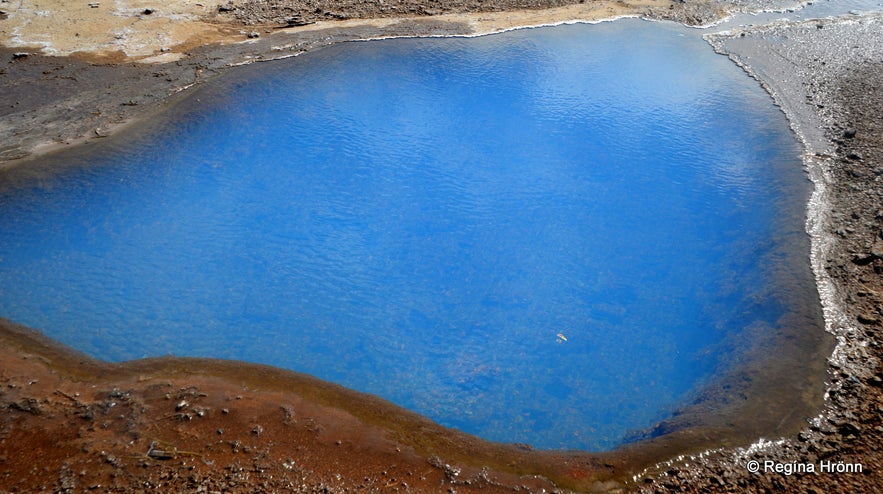 The northern eye of Blesi
The northern eye of Blesi
Blesi (which is a common name for a horse here in Iceland) consists of 2 hot springs; the northern hot spring and the southern hot spring. The northern hot spring is the one sporting this fabulous blue colour, which stems from colloidal silica when it comes in touch with the atmosphere, or something of that sort ;)
Not that I understand this, but I adore the effect it has on the water in the northern eye.
I have seen the northern eye lose its fabulous colour and become reddish and cold with ice on top on a cold March day on my last visit to Geysir. That was a sad sight for me.
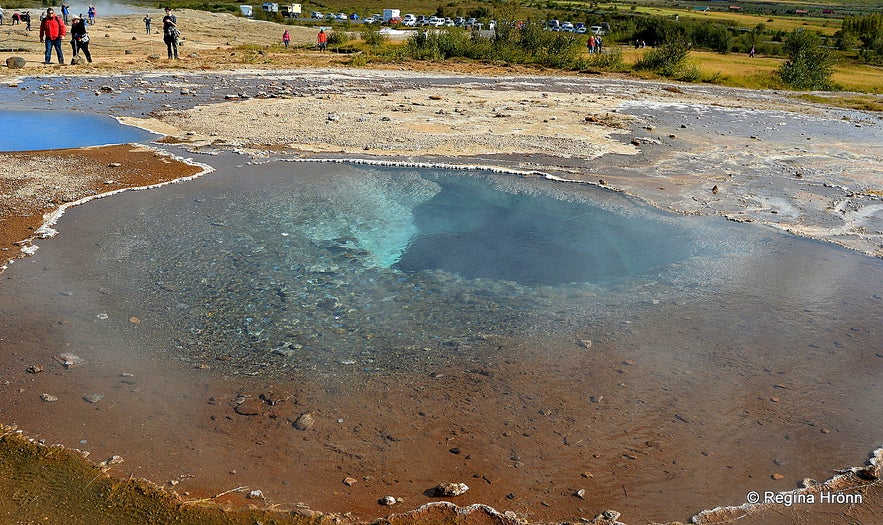 The southern eye of Blesi
The southern eye of Blesi
The other part of Blesi, the southern hot spring, which is separated from the blue colour by a narrow strip of land (called blesi in Icelandic), is quite different looking; very clear, deep and much hotter than the northern eye.
You can look down into the clear water and see the hole from which the boiling hot water originates.
The water from the southern eye flows over to the northern eye and heats it up, as the northern hot spring is only around 1 metre deep and has got no source of water.
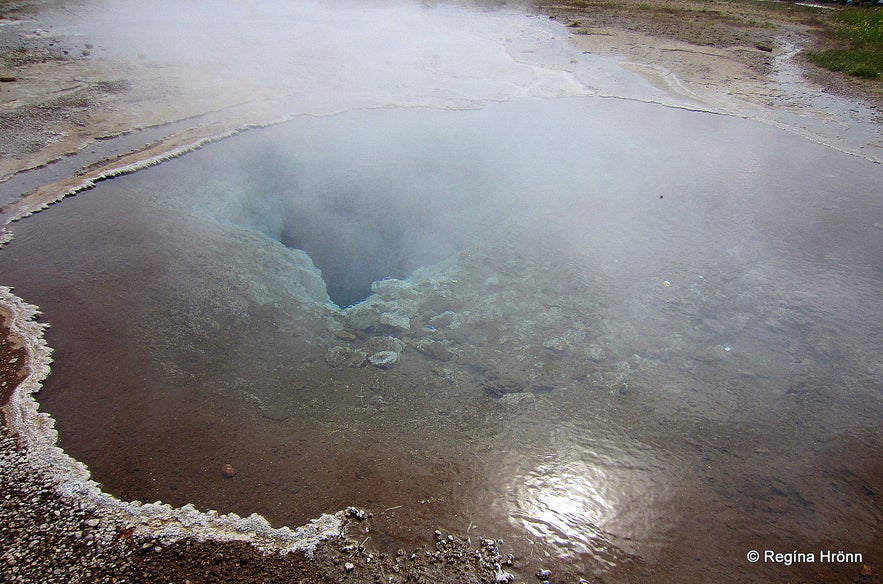 The southern eye of Blesi
The southern eye of Blesi
The temperature in the northern eye of Blesi is around 40 degrees C, and in the early days, a brook, which seems to have been running from Blesi back then, was used by travellers for bathing and washing clothes as it had a comfortable temperature.
And travellers in the old days would heat tea and heat up food in pots in Blesi.
The water was good enough to be used for tea, to warm up the visitors who had to spend days in a tent in the Geysir geothermal area waiting for Geysir or Strokkur to erupt.
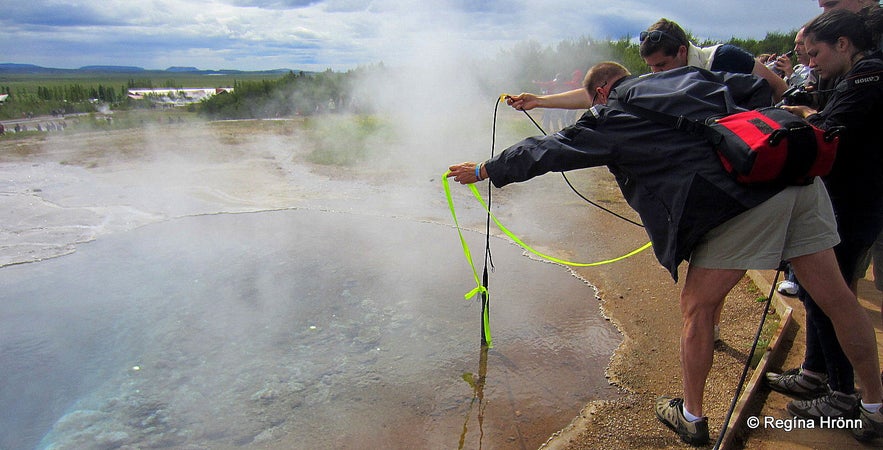 A group of students measured the water in Blesi. You can see coins sparkling in the hot spring
A group of students measured the water in Blesi. You can see coins sparkling in the hot spring
What irritates me a lot is spotting coins in Blesi hot spring :(
By the entrance of the Geysir geothermal area, people are urged not to leave garbage in this area and not to throw coins into the hot spring. It is littering and damaging and we don't want any of that in nature today.
There is one fissure at Þingvellir national park where it is allowed to throw coins and make a wish; at Nikulásargjá a.k.a. Peningagjá - Money Fault, only in that one spot in Iceland, nowhere else.
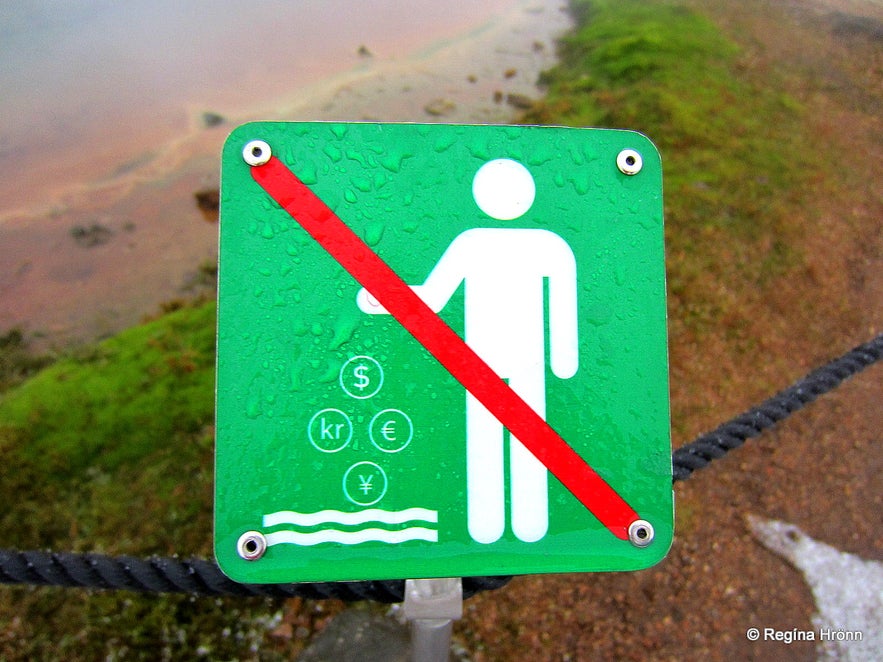 No throwing of coins into hot springs
No throwing of coins into hot springs
And when you see us locals throwing money into Peningagjá then we are making a wish, and we have to follow the coin with our eyes until it lands on the bottom of the rift.
This has been a tradition since Nikulásargjá was bridged back in 1907, and people started throwing coins into the fissure.
I learnt this from my grandparents who had a summer cottage at Þingvellir. And I still do it when I visit Þingvellir.
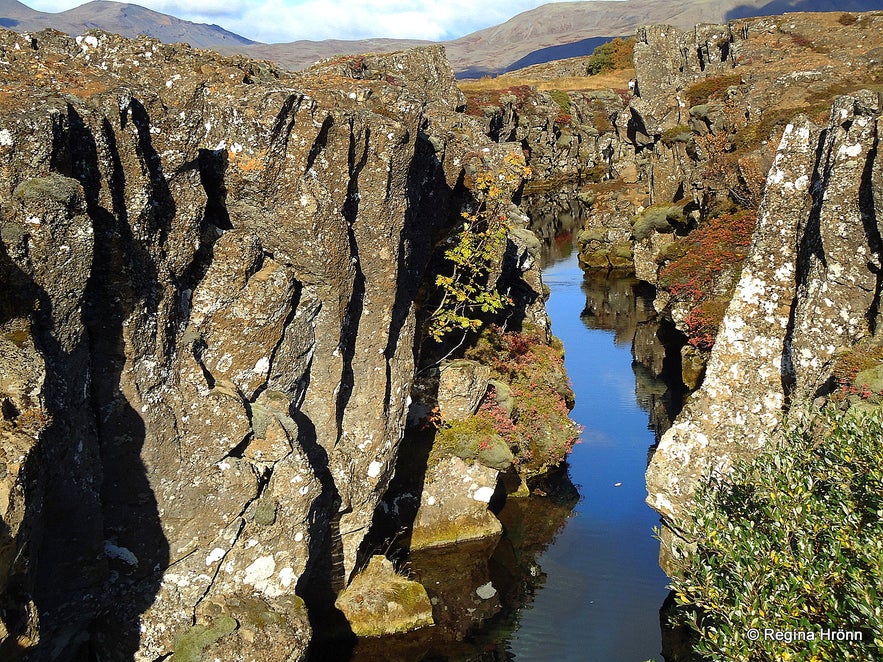 Nikulásargjá also know as Peningagjá at Þingvellir national park
Nikulásargjá also know as Peningagjá at Þingvellir national park
If you google Peningagjá the first link that comes up is an April Fools' Day joke on the official website of the national park, telling us that it was only allowed to throw Icelandic coins into the fissure and that they were charging people who wanted to throw coins into the fissure ;)
See also:
A Local's Experience of the Golden Circle Tour in Iceland
Konungshver hot-spring
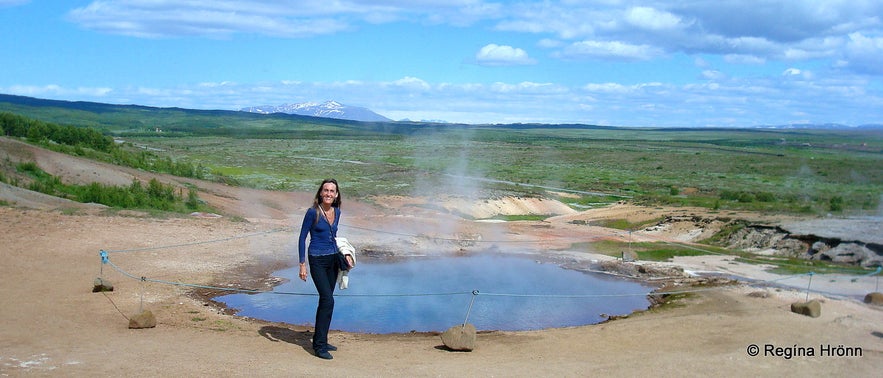 Konungshver can look like this...photo taken in the summer of 2008
Konungshver can look like this...photo taken in the summer of 2008
One of the hot springs in the Geysir geothermal area is called Konungshver - the King's hot spring or the Royal hot spring.
It is at the west end of the Geysir geothermal area above Geysir and Blesi. It is named after the Danish King Christian IX, who visited Geysir back in 1874.
Geysir didn't erupt for the king, but clods of turf were thrown into the bowl of Strokkur to force it to erupt for the king. This practice, might with time have blocked the shaft of Strokkur so it stopped erupting.
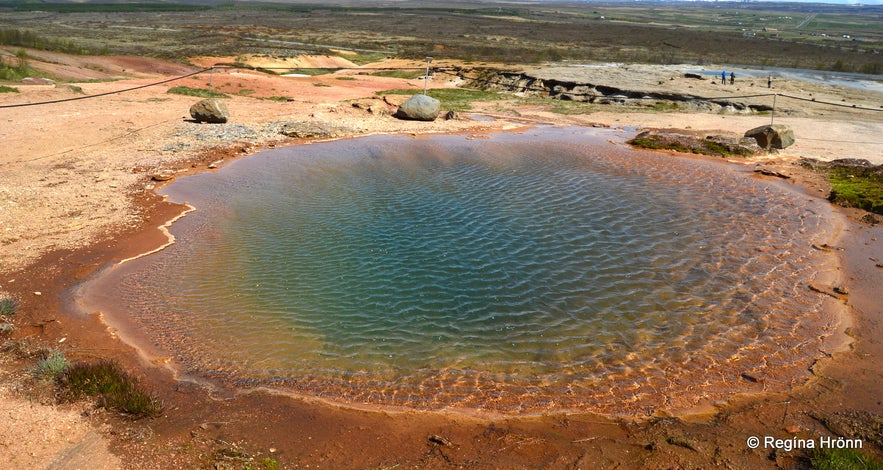 ...and Konungshver can look like this - ever-changing. Below it, you see people by Geysir
...and Konungshver can look like this - ever-changing. Below it, you see people by Geysir
Konungshver appeared some 20 years after the king's visit, or in 1896 after a big earthquake, and even erupted 1 m in the air, gradually becoming smaller and smaller.
At the bottom of Konungshver, there are some rocks that might be blocking the shaft.
Then again after the earthquakes in 2000 Konungshver became active with spouts from 1.5 - 1 m in the air.
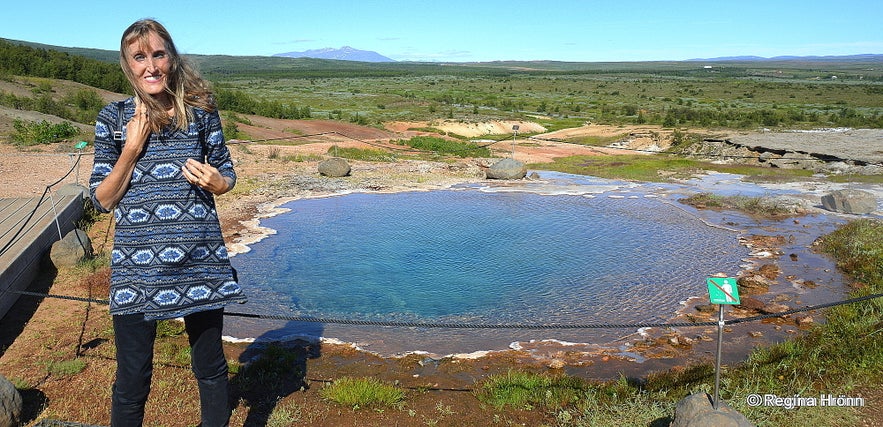 Konungshver hot spring in the summer of 2020
Konungshver hot spring in the summer of 2020
Konungshver changes in colour and never looks the same to me. I have had my photo taken by it for 19 years now and it always looks different to me.
If you look closely up at the hill behind Konungshver in my next photo, you will see 3 rocks with some carvings on them.
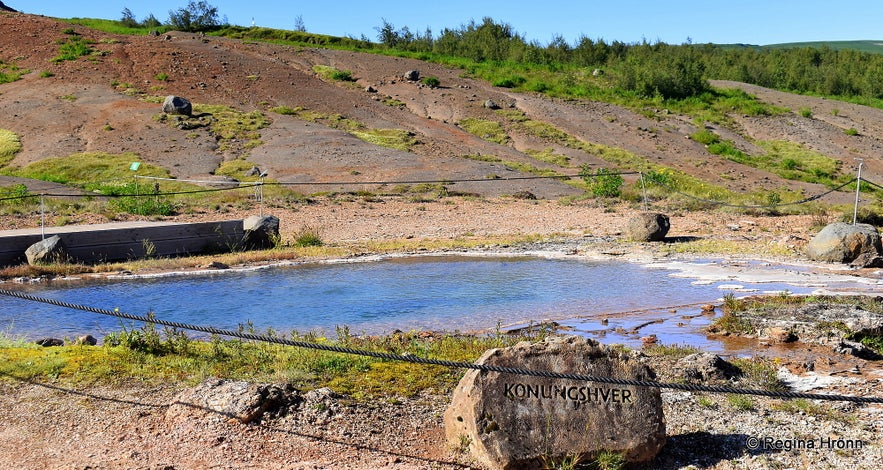 Konungshver hot spring and the 3 Konungssteinar rocks
Konungshver hot spring and the 3 Konungssteinar rocks
One of the rocks is almost hidden by the vegetation. These 3 rocks are called Konungasteinarnir or the Rock of the Kings.
The initials of 3 Danish kings are carved in these rocks to commemorate the Iceland visit of these kings.
Of course, they visited the Geysir geothermal area.
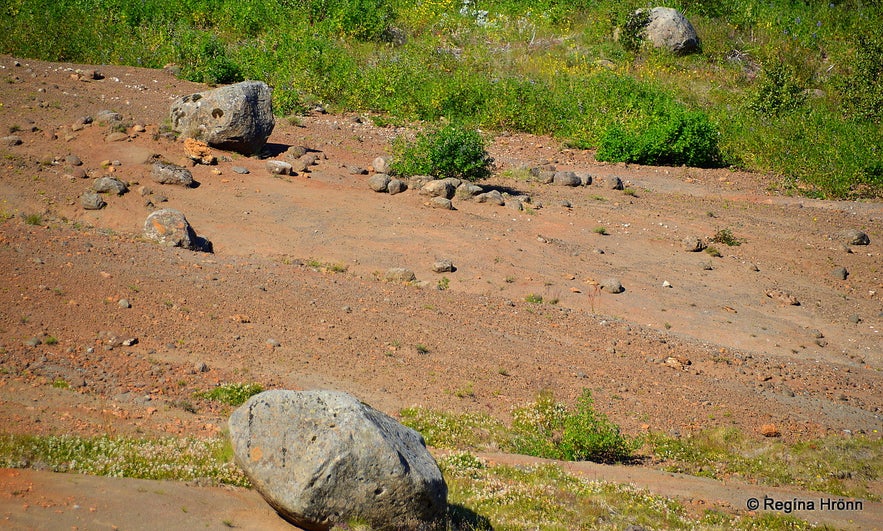 The 3 Konungasteinar rocks on the hill above and to the right of the Konungshver hot spring
The 3 Konungasteinar rocks on the hill above and to the right of the Konungshver hot spring
CIX 1874 is carved in the 1st rock in my photo below, meaning King Christian IX who visited this area back in 1874.
The other rocks have the names of the Danish Kings Frederik VIII (1907) and Christian X (1921).
I was not able to get a clear enough photo with the initials of Christian X as it is almost hidden away in the trees.
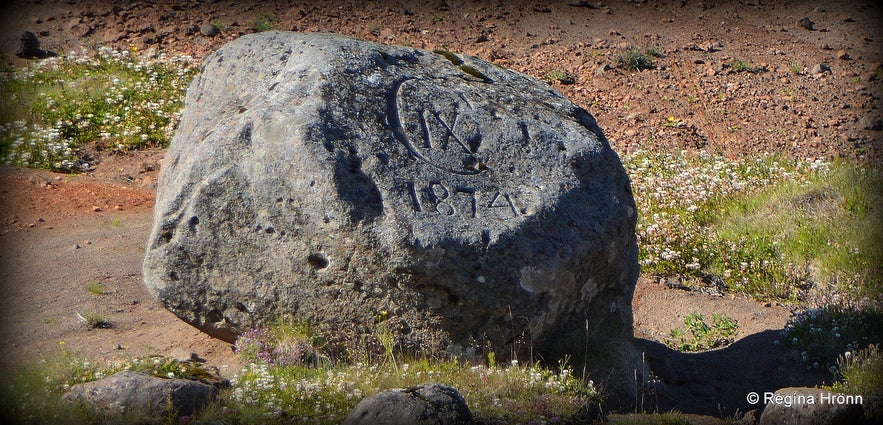 King Christian IX visited in 1874 - I zoomed in on this rock
King Christian IX visited in 1874 - I zoomed in on this rock
But in my photo below you will see the initials of King Frederik VIII who visited Iceland back in 1907.
I have read an old book about his Iceland visit, called 1907, and he arrived with a large entourage of ministers and politicians and such and they had a lot of fun on this tour.
The Danish King Frederick VIII visited Iceland back in 1907 - I had to zoom in from afar, this is the best I could do.
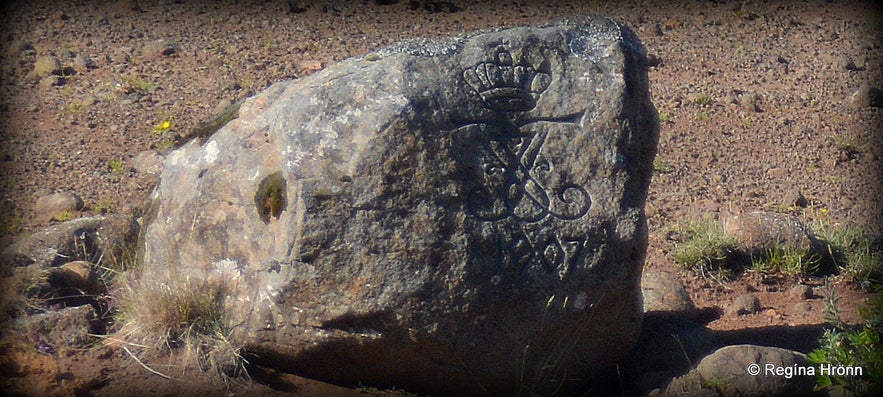
Frederick VIII
I had to zoom in as much as I could to be able to get the photos and that is why they are out of focus, but they give you a general idea of the stones, which very few people notice.
It is a shame that these rocks cannot be visited. These 3 rocks are natural rocks and as there are only 3 of them only the names of 3 Danish kings were added.
Mt. Laugarfjall - Laugarfell
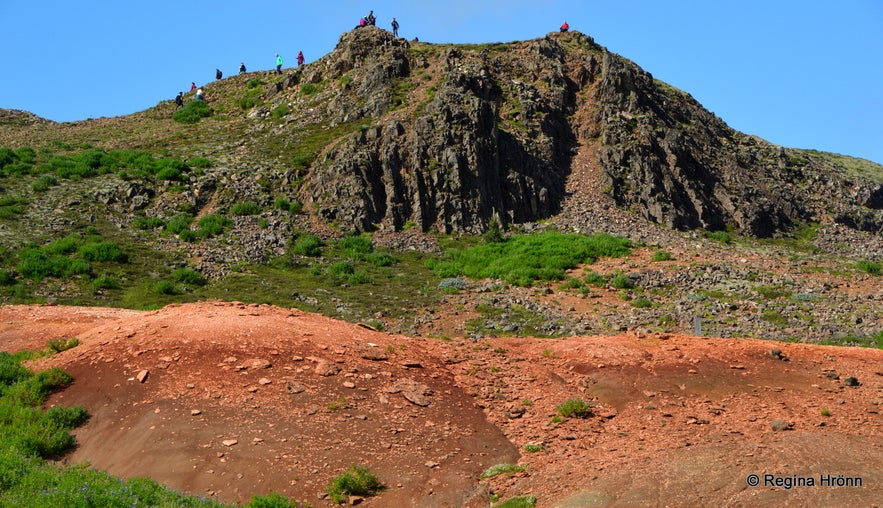 Mt. Laugarfjall - Laugarfell - photo taken from Konungshver hot spring. I love the maroon colour
Mt. Laugarfjall - Laugarfell - photo taken from Konungshver hot spring. I love the maroon colour
Mt. Laugarfjall - Laugarfell rises above the geothermal area. The reason why I put 2 names is that on the map of the National Land Survey of Iceland I found Laugarfjall, but on the view-dial is written Laugarfell.
On the way to Mt. Laugarfjall, you will pass a beautiful view-dial and a sundial designed by Jón J. Víðis back in 1965.
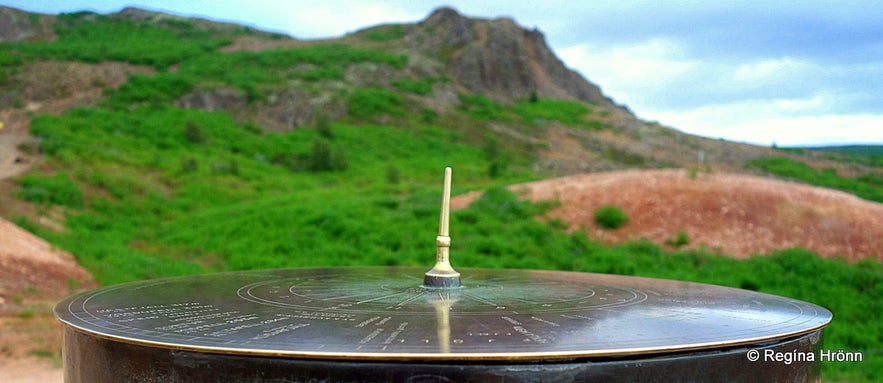 The Geysir view-dial
The Geysir view-dial
His assistant and nephew was Jakob J. Hálfdanarson, who is my father-in-law, but he took over from Jón J. Víðis and designs the view-dials now.
I stop by all the view-dials I can find on my travels in Iceland and take photos of them for my collection, but all in all, there are a little under a hundred view-dials in various locations in Iceland.
Many people hike up the mountain Laugarfjall while visiting the Geysir geothermal area.
It is a short hike and gives you an excellent view of the geothermal area and Haukadalur valley.
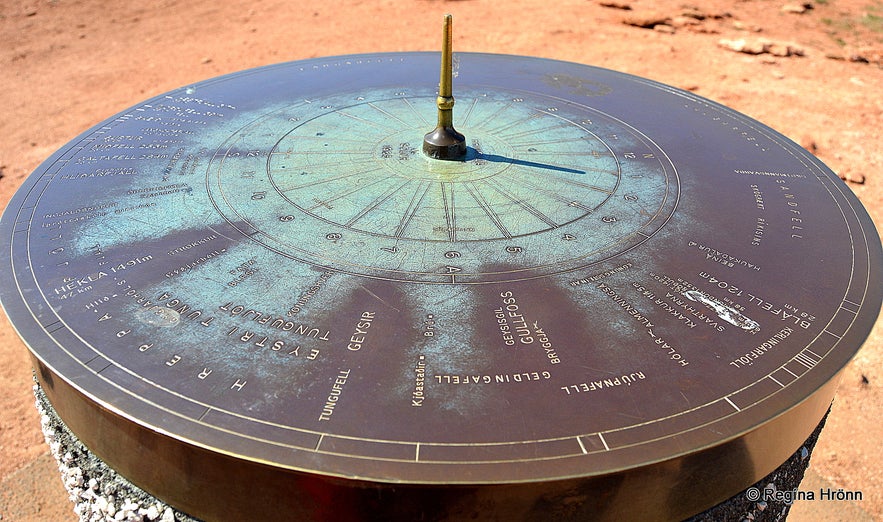 The Geysir view-dial
The Geysir view-dial
I hiked to the top of Mt. Laugarfjall for the first time in the summer of 2020, after a path and observation platforms had been added.
On the way, you will pass a hot spring with bright geothermal colours.
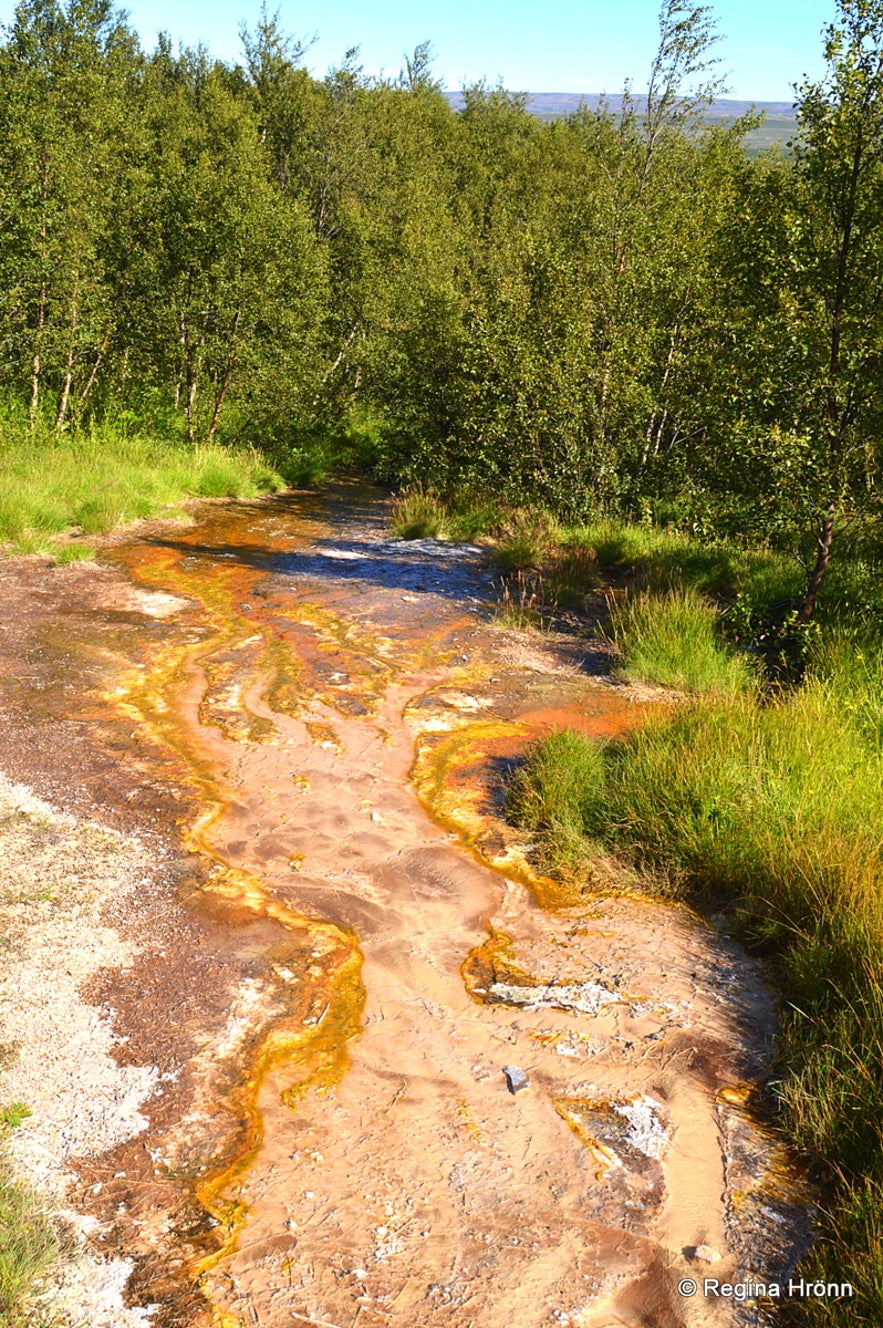 Geothermal colour on the hike up Mt. Laugarfjall
Geothermal colour on the hike up Mt. Laugarfjall
You follow the path leading from Konungshver hot spring straight up to Mt. Laugarfjall.
The last time I visited 2 observation platforms had been added, one pointing away from the geothermal area into Haukadalur valley.
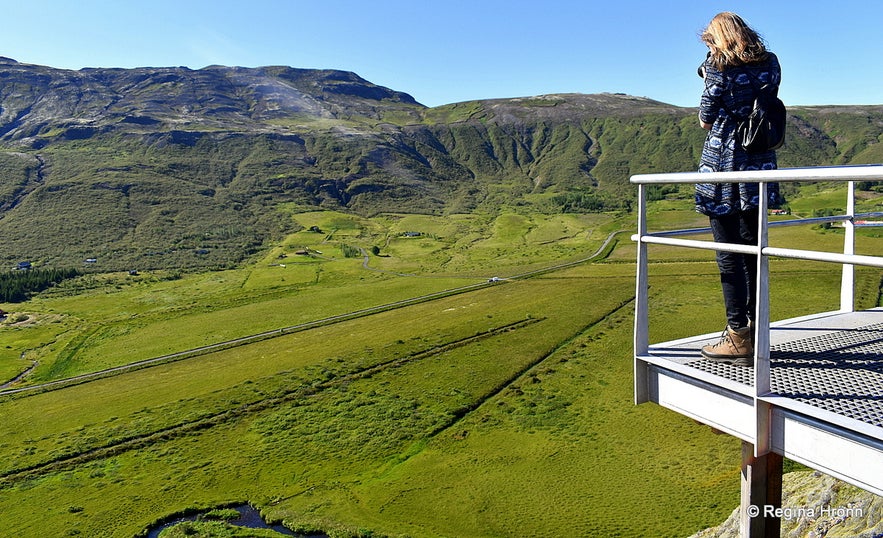 The observation platform with a view of the valley pointing from the geothermal area
The observation platform with a view of the valley pointing from the geothermal area
The other observation platform offers a view of the geothermal area.
The observation platforms are a fantastic addition to the Geysir geothermal area. This is a highly recommended hike given that you have enough time during your Geysir visit.
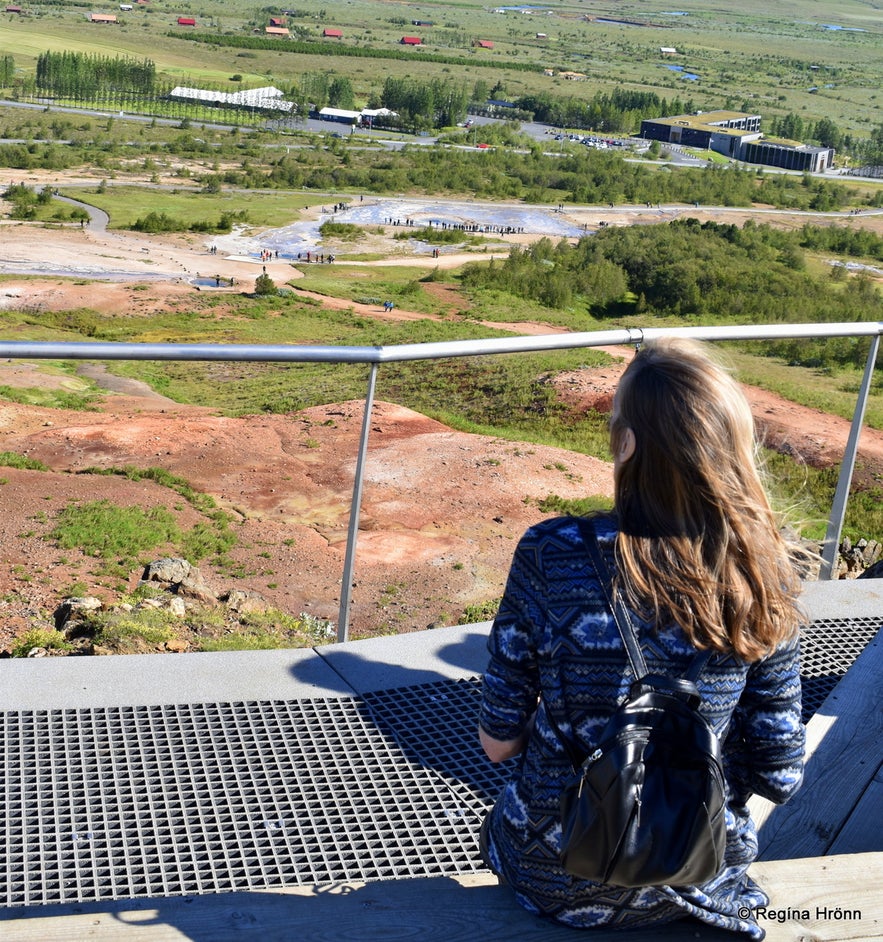 The observation platform on top of Mt. Laugarfjall with a view of the Geysir geothermal area
The observation platform on top of Mt. Laugarfjall with a view of the Geysir geothermal area
I usually don't have enough time when I am showing my foreign visitors the Golden Circle, but in the summer of 2020 nobody came from abroad to visit us, so we had plenty of time to travel in our country at our own pace.
Litli-Geysir and all the other smaller hot-springs
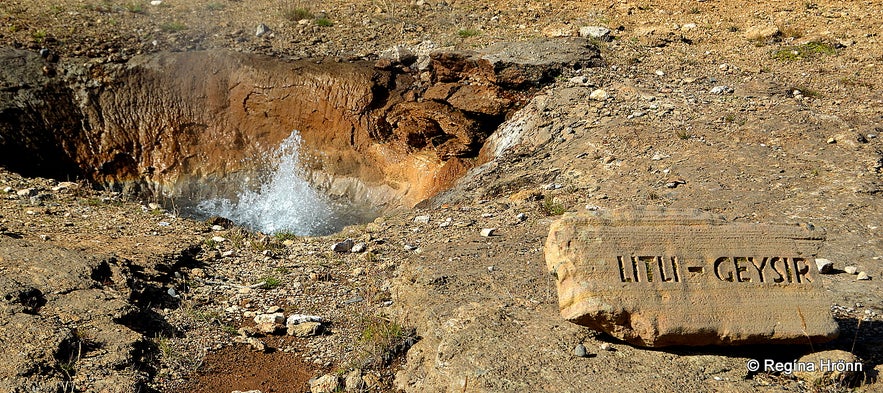 Litli-Geysir
Litli-Geysir
There are several small hot springs in the Geysir geothermal area, especially in the south end. One of them is called Litli-Geysir or the Little Geysir.
Litli-Geysir is a small hole with bubbling and boiling water.
Litli-Geysir sometimes spouted 6-9 m in the air following an earthquake and was once one of the 3 active geysers in the geothermal area.
Smiður - the Carpenter
 Smiður hot spring
Smiður hot spring
Smiður - the Carpenter is another churning and bubbling hot spring in this area.
Prior to the royal visit of the Danish King Frederik VIII, apparently, a carpenter dug out Smiður and thus it got its name. Sometimes soap was added to Smiður, which made it erupt 3-7 m in the air.
Soap was frequently used to force the hot springs to spout, but as I told you earlier then this practice stopped in 1992.
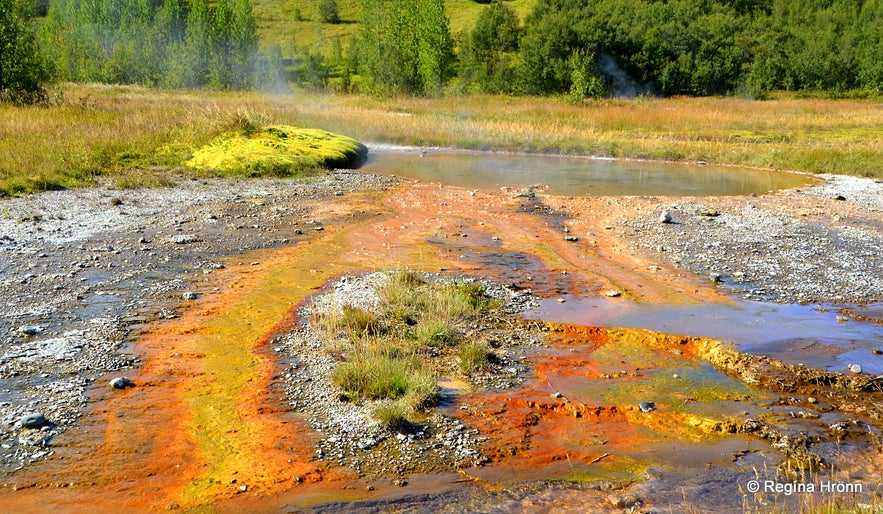 A colourful hot spring in the Geysir area
A colourful hot spring in the Geysir area
The reason why soap was used to make the hot springs erupt might stem from when laundry was done in the hot springs and soap was used in the process, maybe resulting in an eruption. It is just a suggestion on my behalf though.
Soap was first put in a hot spring around 1900 so this practice lasted for almost 100 years.
There are so many geothermal springs inside the closed-off area that I must confess that I don't know which is which as I didn't see any signs, apart from that by Litli-Geysir and Smiður. One of them is called Litli-Strokkur - Little Strokkur.
The hot spring in my video was the most active one of those I could spot from the path, together with Litli-Geysir, which was boiling and bubbling.
This hot spring was constantly boiling and water from it was forcefully bubbling into the air.
On the map below you can see how many other hot springs there are in the Geysir geothermal area. I haven't seen them all as they are fenced off, but have tried my best to identify them and find information about them.
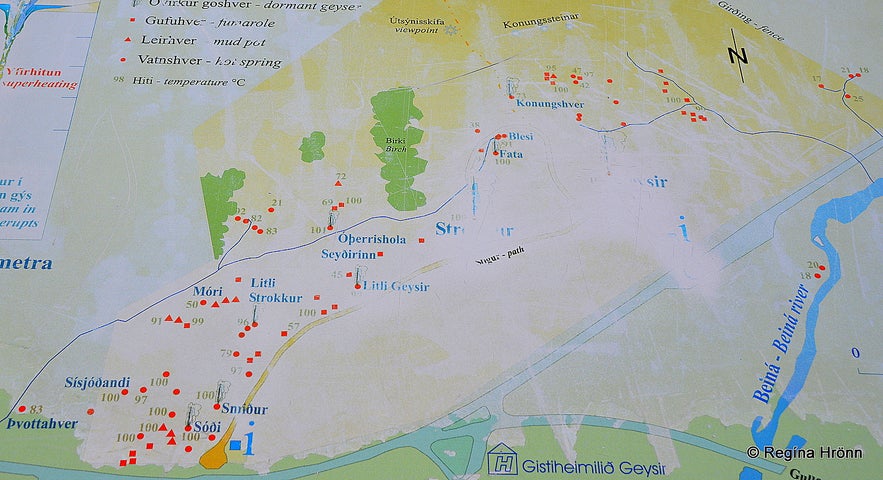 Parts of the map at the Geysir geothermal area
Parts of the map at the Geysir geothermal area
The following website is the absolute best source I have found on geothermal areas around the world:
Another hot spring which used to spout is Fata - Bucket, which apparently is in the shape of a bucket. It is located below Blesi in a now fenced-off area, so I haven't got a photo of it. But after the 2000 earthquakes, it erupted for a while.
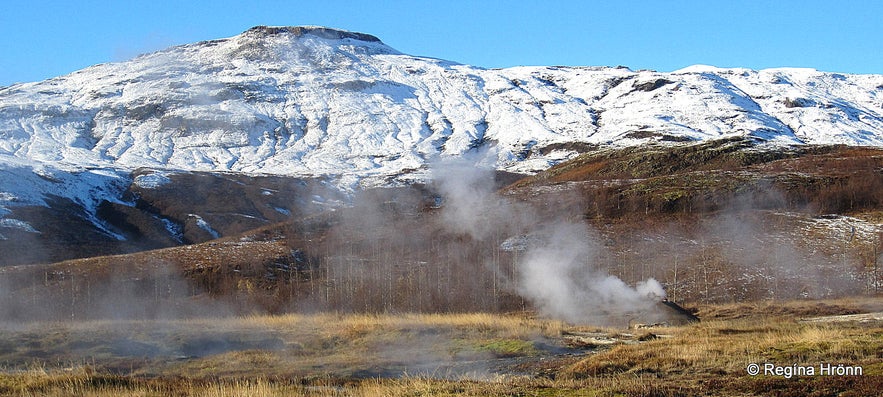 The hot spring area in the wintertime
The hot spring area in the wintertime
Then we have f.ex. Vigdísarhver, Seyðir, Þykkvuhverir (a mud pot area) and Sóði - the Slob, as it erupted dirty water, and Sísjóðandi (constantly boiling), which was apparently used for boiling food at Laugar farm and for laundry.
Óþerrishola (Wet hole or hot spring) can predict rain as it has been known to erupt when the barometer falls. After the earthquakes in 2000, it erupted from time to time.
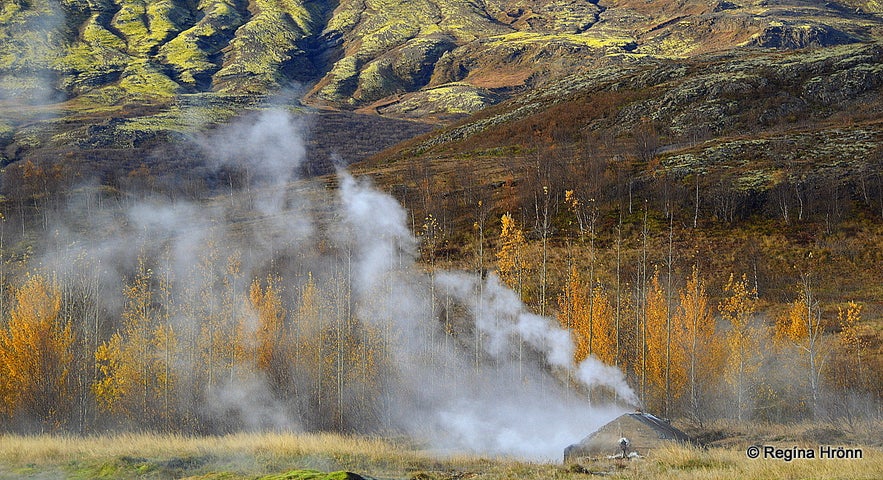 The hot spring area in autumn
The hot spring area in autumn
I hope that sometime in the near future a path will be added around this area, so we can visit its myriad of hot springs and get better acquainted with this part of the Geysir geothermal area.
Never enter this fenced-off area on your own as there are too many hot springs, which makes this a danger zone if you don't know where the hot springs are lurking.
A special type of dark rye bread is traditionally cooked in hot springs in Iceland, and I have sometimes seen the chefs at the restaurants at Geysir come to pick up their bread in the geothermal area.
The bread is cooked for 24 hours in a hole by the hot springs and the bread from the Geysir area is considered to be amongst the best rye bread on the Icelandic market.
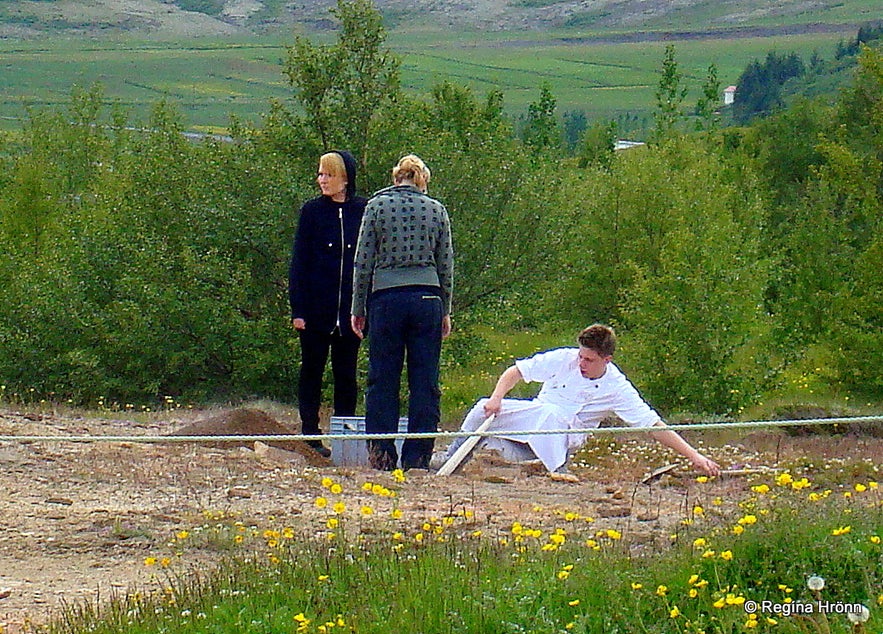 Bread-baking at Geysir
Bread-baking at Geysir
The long cooking procedure breaks down the starch in the bread making it very massive and juicy.
Dangers in geothermal areas
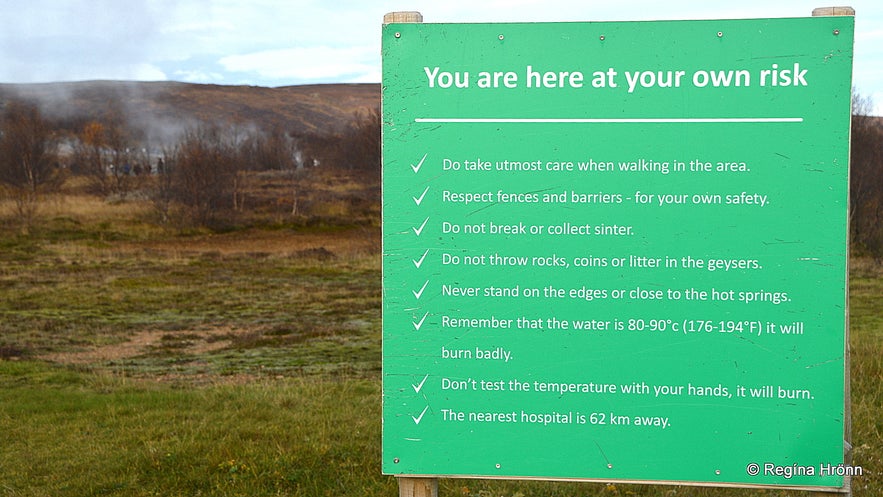 The warning sign by the entrance to the Geysir geothermal area
The warning sign by the entrance to the Geysir geothermal area
Be aware that the whole Geysir area is a high-temperature geothermal area, so stay within the boundaries and never touch the water as it is HOT (80-100 degrees C)!
Geothermal areas are danger zones and should be treated as such.
The dangerous part is that we never know what is going on underneath the thin surface in geothermal areas.
 Watch your step at the Geysir geothermal area
Watch your step at the Geysir geothermal area
That is why there are marked paths. People who have wandered off the marked paths have found themselves stepping into boiling hot water hidden by the grass or hidden beneath a thin crust.
When my mother was around 9 years old, she saw a man stepping through a thin crust here at the Geysir geothermal area, and straight into boiling hot water.
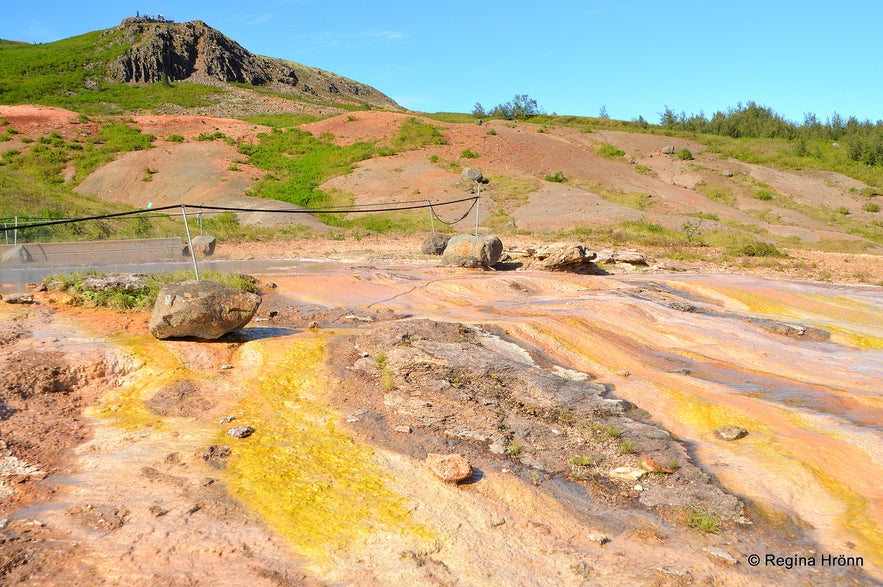 Geothermal colours running from Konungshver hot spring
Geothermal colours running from Konungshver hot spring
She told me about this incident and how the skin on his foot rolled up and left the foot of the poor man raw. That mental image stayed with me and I never take any risks in Iceland's geothermal areas.
She was staying at the hotel for the night and Geysir didn't erupt during the day, but in the middle of the night loud thumps were heard and it was like the earth was being ripped apart, and Geysir erupted beautifully. What a sight it must have been for a young girl :)
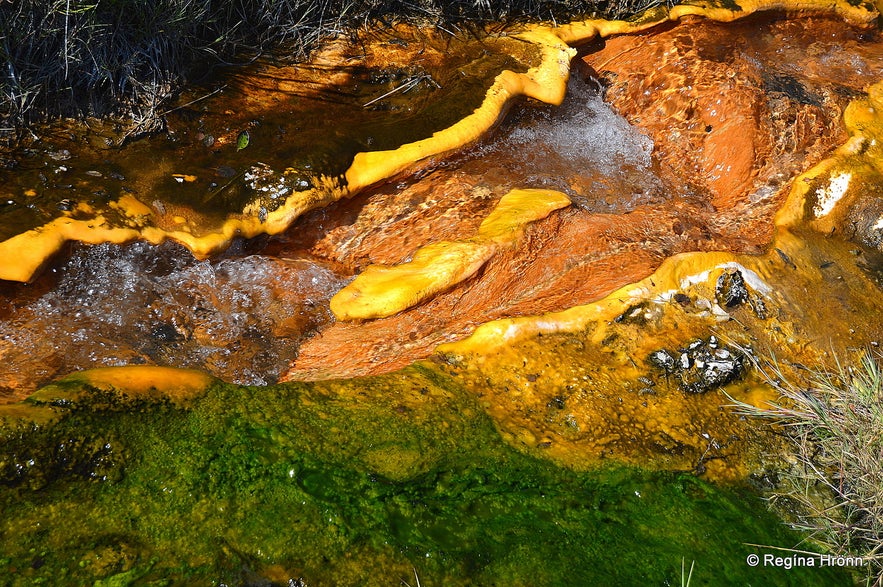 Beautiful geothermal colours at the Geysir geothermal area
Beautiful geothermal colours at the Geysir geothermal area
There never seem to be enough warning signs in geothermal areas, as some people don't know that the water is extremely hot. Or just don't read the signs.
And some even cross the boundaries to get better photos or stick their hand into the geysers to check the temperature, and don't seem to realize how dangerous this is!
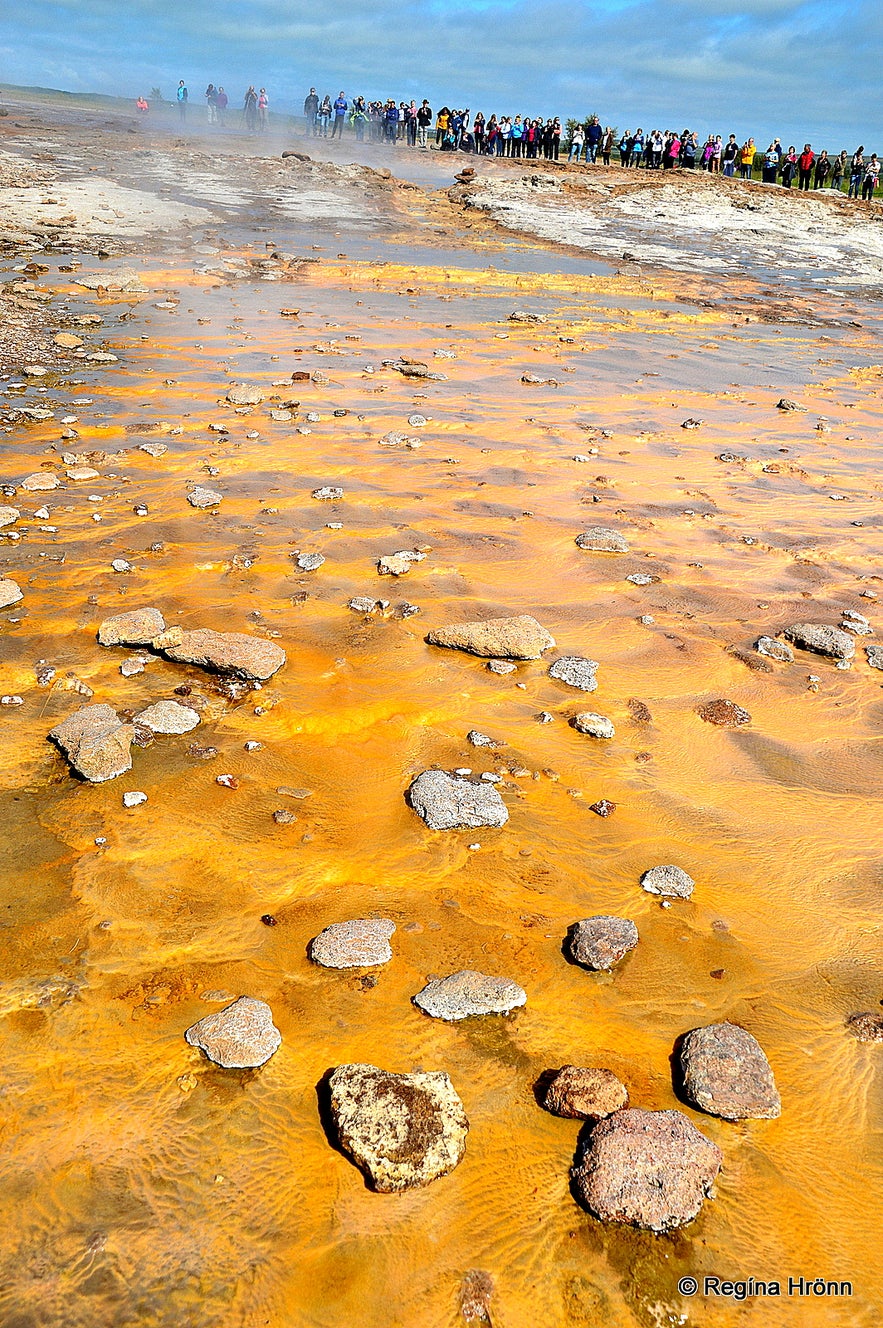 Crowds at the Geysir area waiting for Strokkur to erupt
Crowds at the Geysir area waiting for Strokkur to erupt
The ropes for the marked-off areas are not high, but that doesn't mean less danger, only that we like to keep the geothermal area as intact as possible.
In September 2010 the boundaries/ropes were put higher up so that there should not be any confusion anymore as to where it is allowed to walk in the Geysir geothermal area; only on the paths.
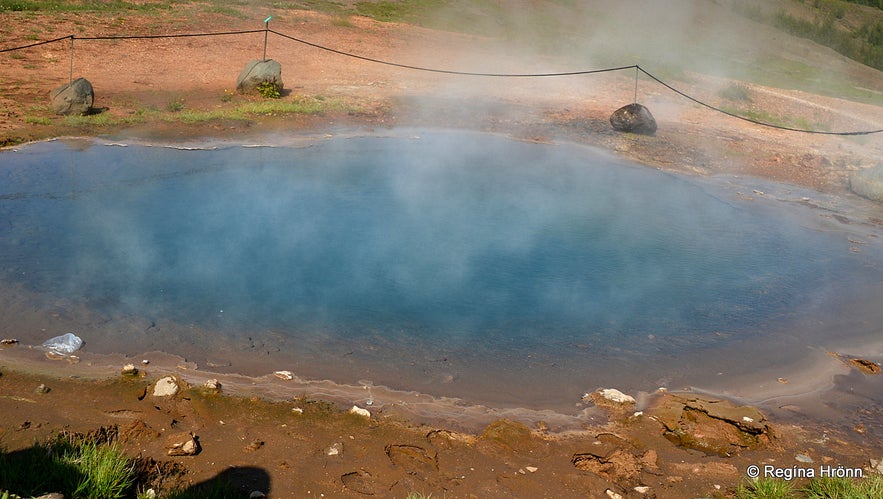 Do you see the footsteps in the mud, way too close to the hot spring in a fenced-off area by Konungshver?
Do you see the footsteps in the mud, way too close to the hot spring in a fenced-off area by Konungshver?
It pains me to see that some people ignore the safety ropes and f.ex. step inside the closed-off Konungshver and leave their footsteps in the mud.
It is both dangerous and inconsiderate. And it is hard to clean geothermal mud from your shoes. It can stick to your shoes like heavy cement as I experienced in the geothermal area at Þeistareykir in North Iceland.
The colourful Þeistareykir Geothermal Area in North-Iceland
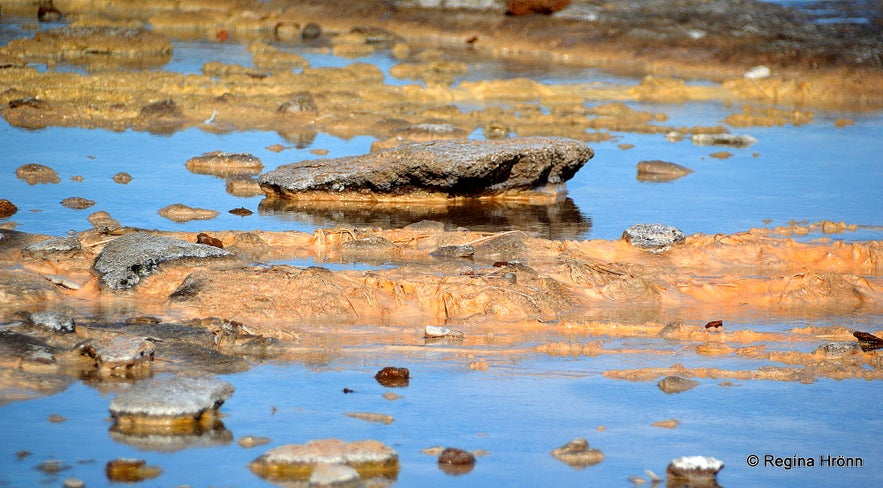 Hot water running from Strokkur
Hot water running from Strokkur
Every year people get injured in the geothermal areas. In 2010 a 2-year-old girl got injured close to Strokkur. She tripped over a rope, which defined the walking paths, and into the run-off water from Strokkur; she got burnt in the face and on her hands :(
In the following years, three children got injured, and a tourist stepped into a hot spring.
Small children should always be carried by their parents in geothermal areas and children should be under supervision the whole time they are visiting this high-temperature geothermal area.
Also, be careful in the wintertime as the paths can be covered with ice and very slippery.
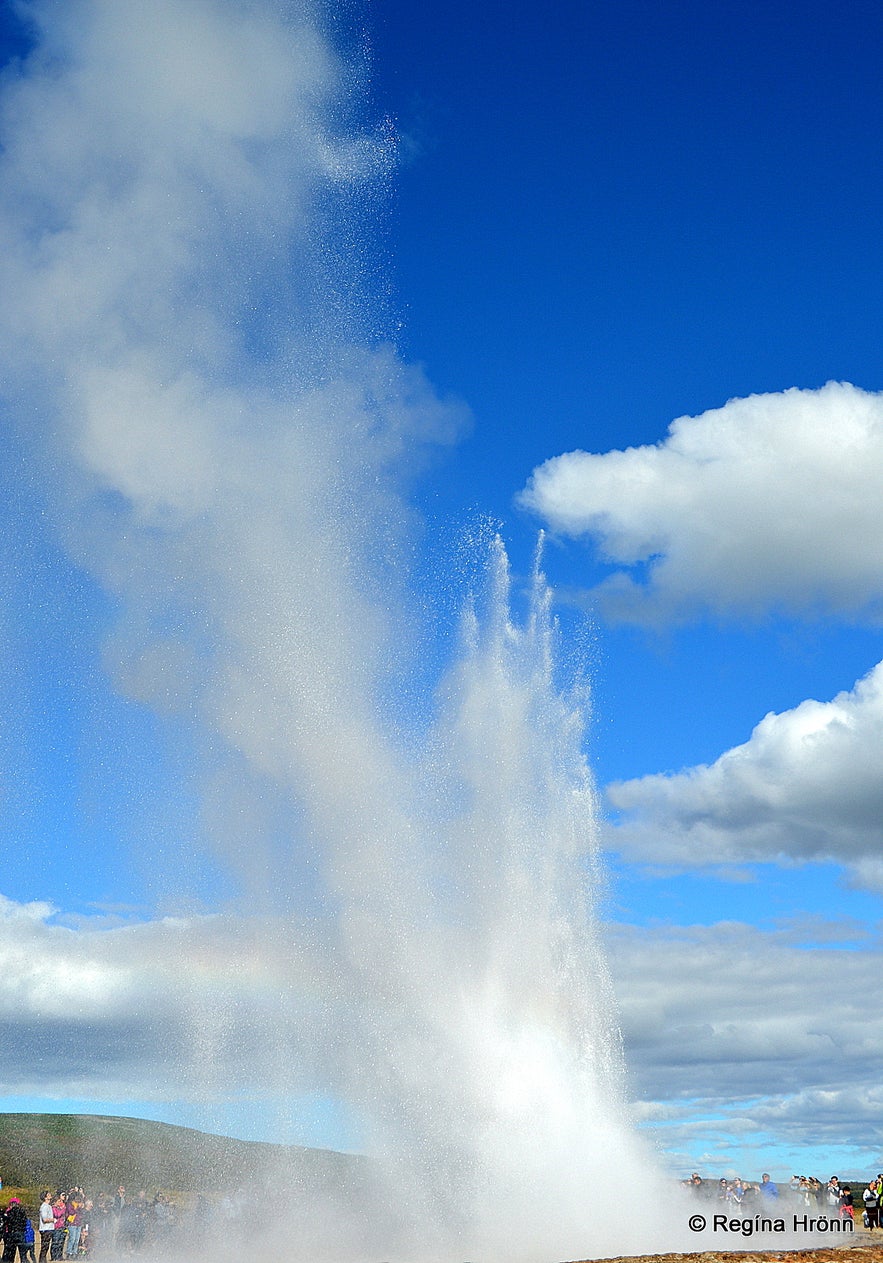 Strokkur erupted and the steam blew towards the people
Strokkur erupted and the steam blew towards the people
An accident took place when a sudden wind blew Strokkur straight towards an Icelandic family which was standing at a safe distance outside the safety lines. So even standing at a safe distance can cause accidents if the wind is blowing suddenly.
A helicopter had to come and fly the family to the nearest hospital, which is 62 km away.
Always take the wind direction into account when you choose where to stand to watch Strokkur erupt.
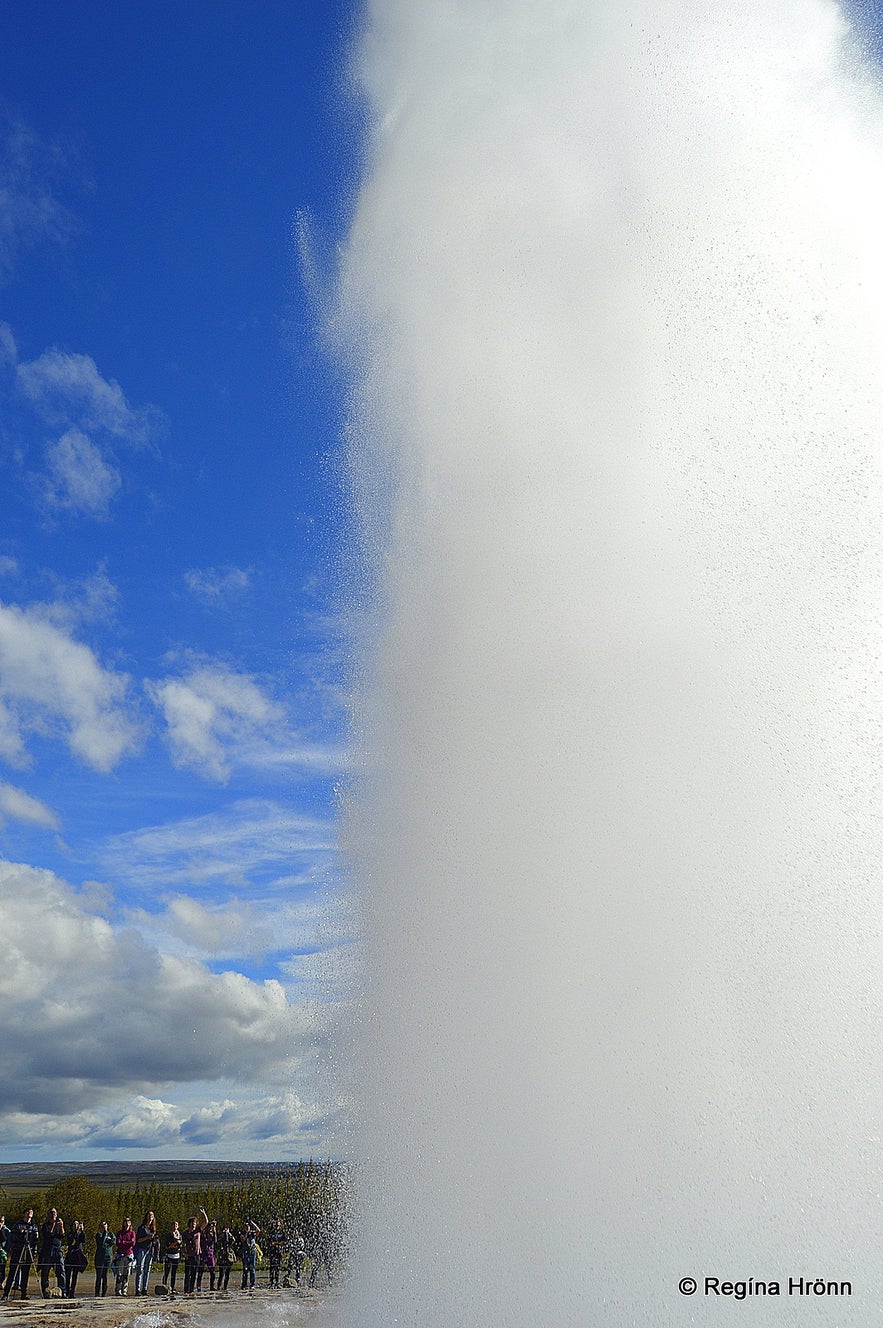 Strokkur erupting
Strokkur erupting
Spectators stand all around Strokkur, which should be ok if no wind is blowing, but as we learned from this accident, a sudden wind can blow the hot water in the direction of bystanders.
One year a tourist got burns on both feet when he stepped into a hot spring in the middle of the night. In the photo below you can see what this area looks like at the dusk.
Never enter these areas after dark as you might accidentally step into a hot spring hidden beneath a thin crust or in the grass.
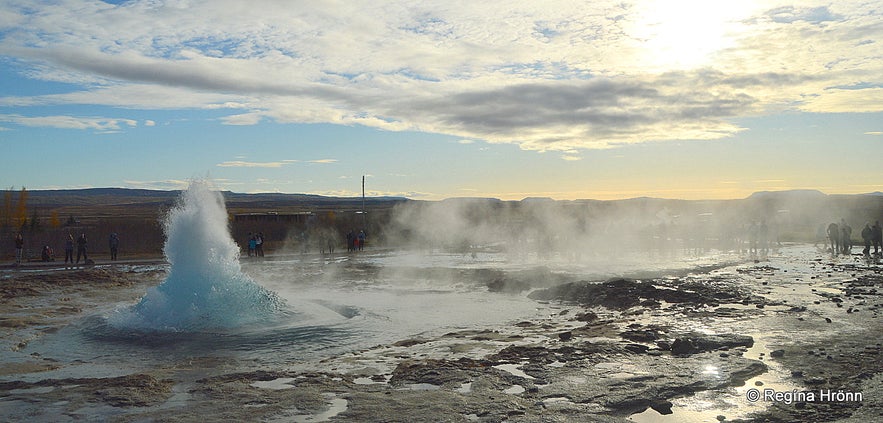 Geysir geothermal area in the dusk - the Strokkur bubble bursting
Geysir geothermal area in the dusk - the Strokkur bubble bursting
I have only once seen Strokkur erupting in the dark.
We reached the Geysir geothermal area in the dark and parked the car in the small northern parking lot and stayed outside the fenced-off area. We had dinner in the car, overlooking the geothermal area.
Nobody was around and then Strokkur erupted out of what seemed to be nowhere in the darkness; a magnificent sight!
We were coming from Mývatn in the north and had returned through the central highland via Kjalvegur - Kjölur road, that is why we were at Geysir so late that night.
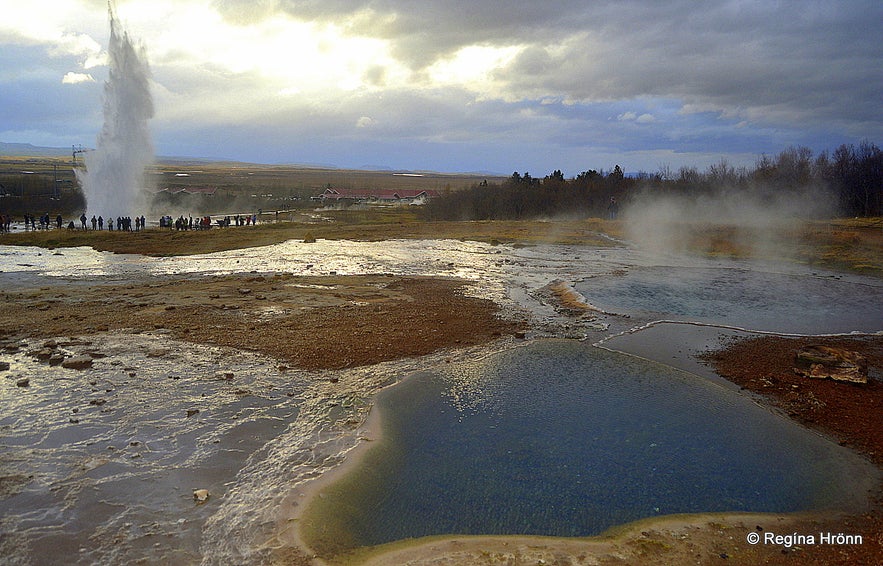 Strokkur and Blesi in the dusk
Strokkur and Blesi in the dusk
We stopped on the way at one of the most magnificent geothermal areas in Iceland; the high-temperature geothermal area Hveradalir in Mt. Kerlingarfjöll in the highland.
See also:
A fascinating Hike through the Geothermal Area of Hveradalir in Mt. Kerlingarfjöll via Kjölur Road
The Geysir Troll & Wrestling
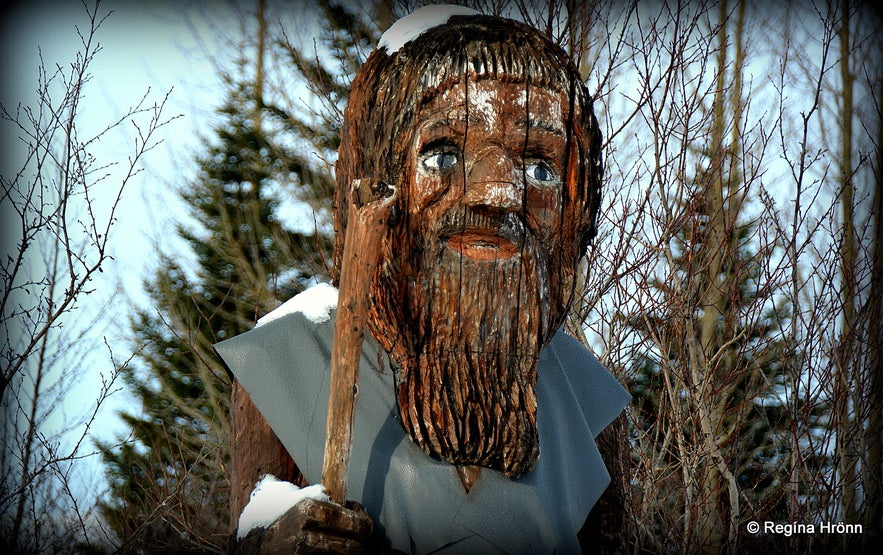 North of the new hotel at Geysir, you will find a troll. It used to stand by a bench in a prominent place but has been moved during the construction work.
North of the new hotel at Geysir, you will find a troll. It used to stand by a bench in a prominent place but has been moved during the construction work.
I have my photo taken by it every time I visit the Geysir geothermal area.
Icelandic folklore is filled with stories about trolls and elves in Iceland and in many places in Iceland you will find petrified trolls, who didn't reach their cave and got turned into stone by the first rays of the sun.
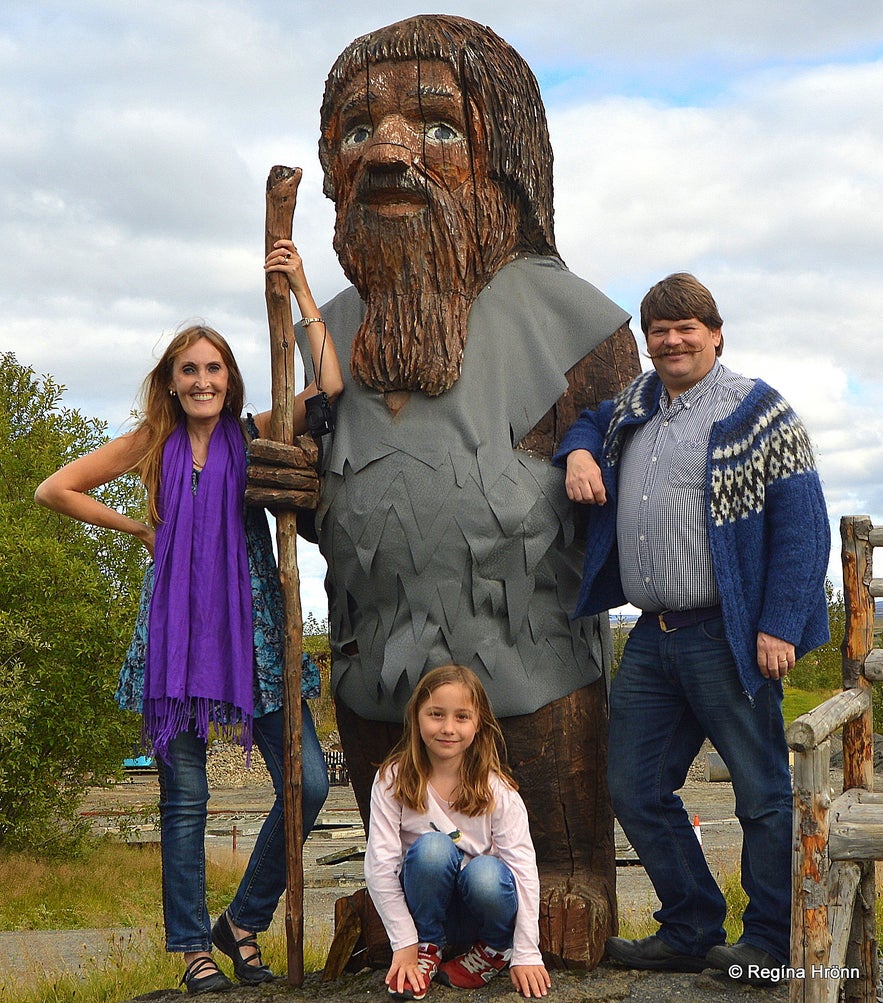 By the Geysir troll Bergþór í Bláfelli in its old location
By the Geysir troll Bergþór í Bláfelli in its old location
I have written a special travel-blog about the Geysir troll in which I translated the folklore into English and also tell you about other famous characters in Iceland known to Bergþór:
The gentle Troll Bergþór in Mt. Bláfell - Icelandic Folklore
You can also visit the Haukadalsskógur area which is next to the Geysir geothermal area:
A Visit to the Icelandic Haukadalsskógur Forest with a Dip in Kúalaug Hot Pool
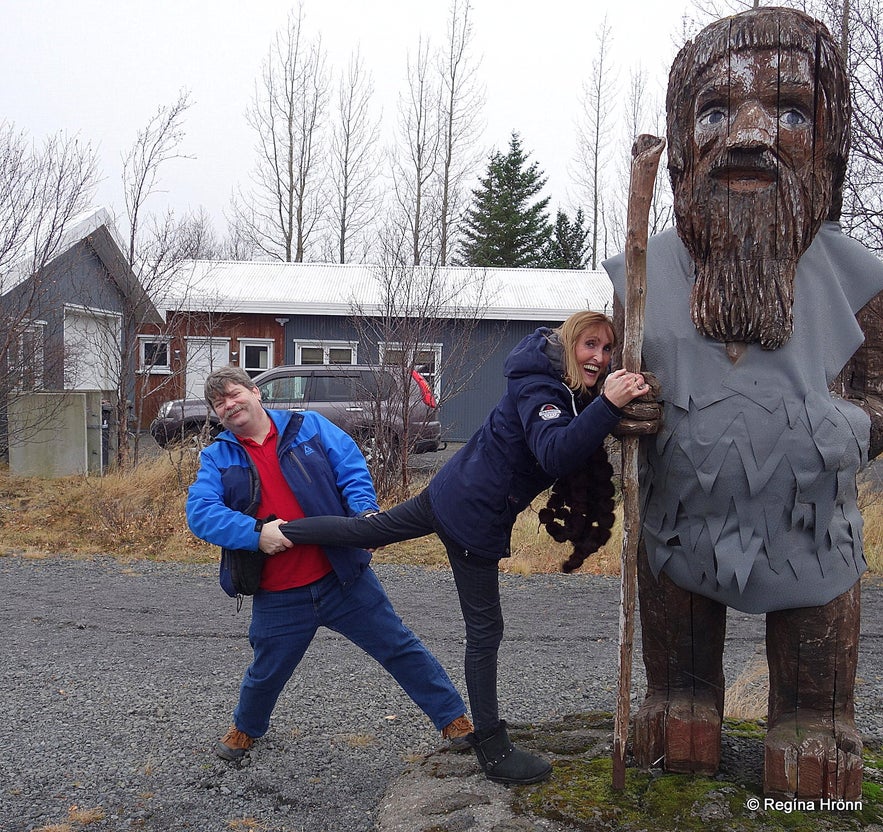 By the Geysir troll Bergþór í Bláfelli in its new location in November 2022
By the Geysir troll Bergþór í Bláfelli in its new location in November 2022
See also other troll stories:
Kerlingarskarð Pass in Snæfellsnes in West-Iceland - the Folklore of the Giantess & her Fiancé
You might also notice another statue of two guys in a strange position and wonder what it represents. I am often asked what on earth the guys are doing. This is a wooden statue of two men wrestling or glíma as we say in Icelandic.
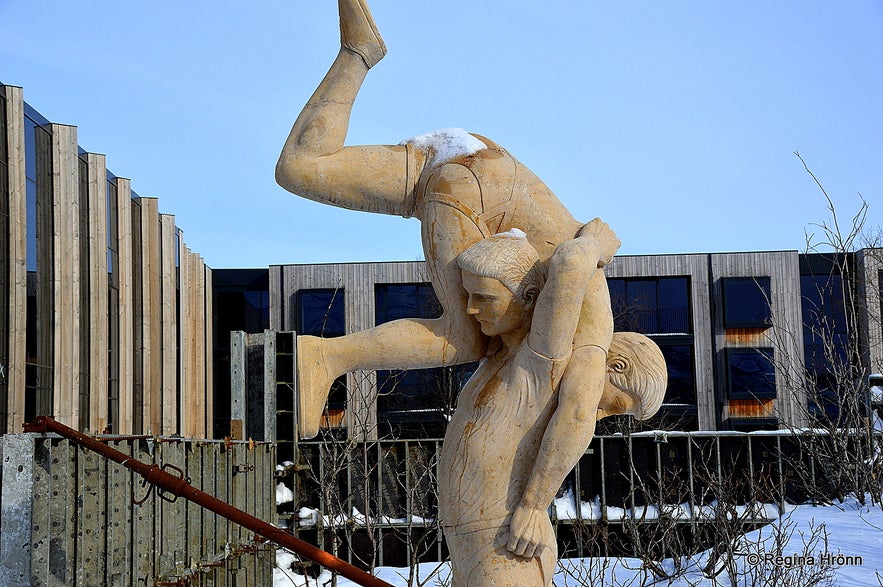 The wrestling statue and the brand-new hotel, the photo was taken in 2019
The wrestling statue and the brand-new hotel, the photo was taken in 2019
One of them is Sigurður Greipsson (1897-1985), who built and founded a Sporting Academy at Geysir in Haukadalur (1927-1971), Iceland's first Sporting Academy.
Sigrður was a great wrestler and he held the title of the Wrestling King of Iceland for 5 consecutive years.
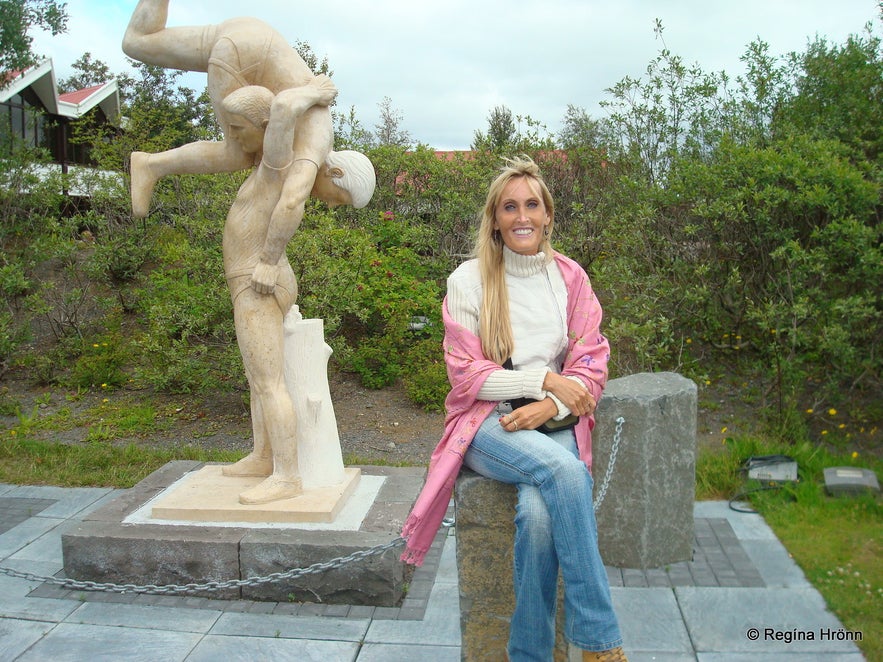 This photo was taken back in 2010 when the wresting statue was brand-new - the old hotel in the background
This photo was taken back in 2010 when the wresting statue was brand-new - the old hotel in the background
You will also notice a huge statue of wrestlers in the restaurant area at Geysir by Lucy Unwin. The theme at Geysir is wrestling in honour of the memory of Sigurður.
Wrestling was a national sport in Iceland, and you can read more about Sigurður and wrestling on the following website: Geysir Glíma.
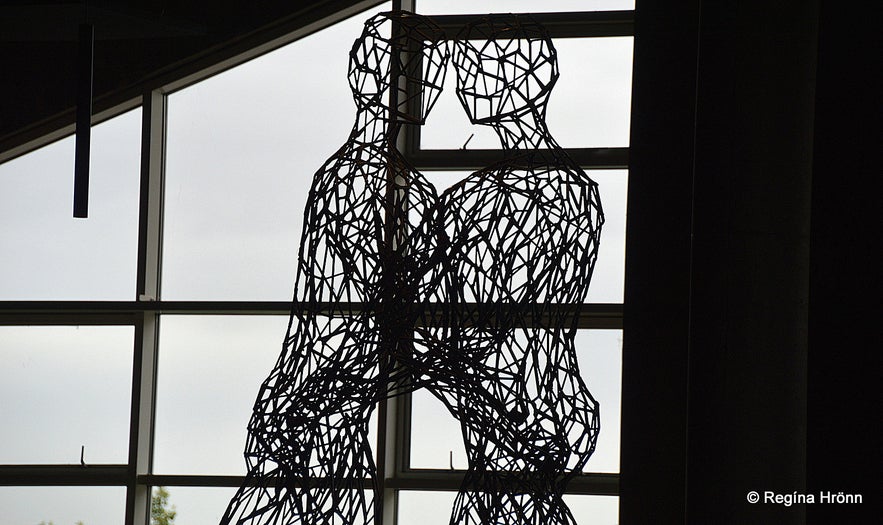 The statue of the wrestlers in the restaurant
The statue of the wrestlers in the restaurant
The Geysir geothermal area is 100 km away from Reykjavík and the Golden Circle is around 250 km, depending on detours, and will normally take some 8 hours to complete with stops.
To visit this area you can rent a car in Reykjavík or join one of the many Golden Circle tours. If you rent a car then you can also visit the stunning Brúarfoss waterfall:
The beautiful Brúarfoss waterfal - is the the Bluest River in Iceland
I have found one Golden Circle tour which includes Brúarfoss waterfall: Small-Group Golden Circle Minibus Tour from Reykjavik with Bruarfoss Waterfall & Kerid Crater.
There might be more, I will add them if I come across them.
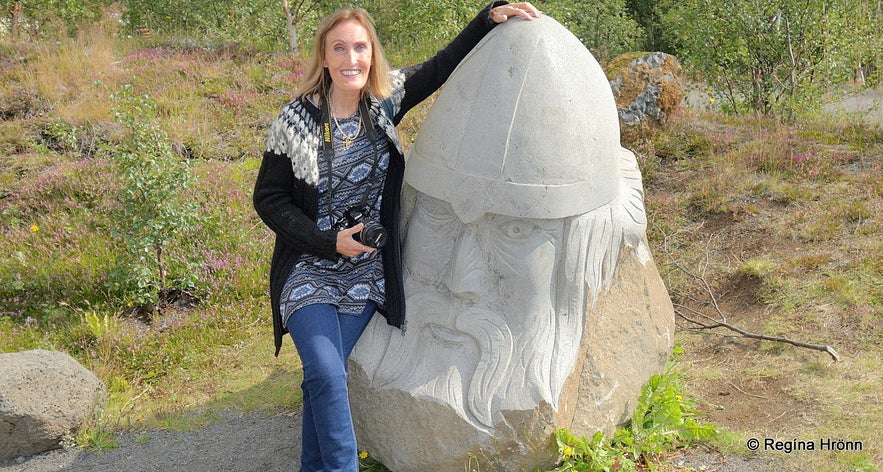 You will find this Viking head at Geysir
You will find this Viking head at Geysir
Have a lovely time at the Geysir geothermal area and stay safe :)
The nearest attraction is the majestic Gullfoss, the Golden waterfall which gives a name to the Golden Circle:
The Majestic Gullfoss - Iceland's Golden Waterfall, which gives a Name to the Golden Circle
You can also visit the Silver Circle in West Iceland and the Diamond Circle in North Iceland:
Sources:
Hvítá frá upptökum til ósa - Hjálmar R. Bárðarson
Íslandsferð J. Ross Browne 1862








